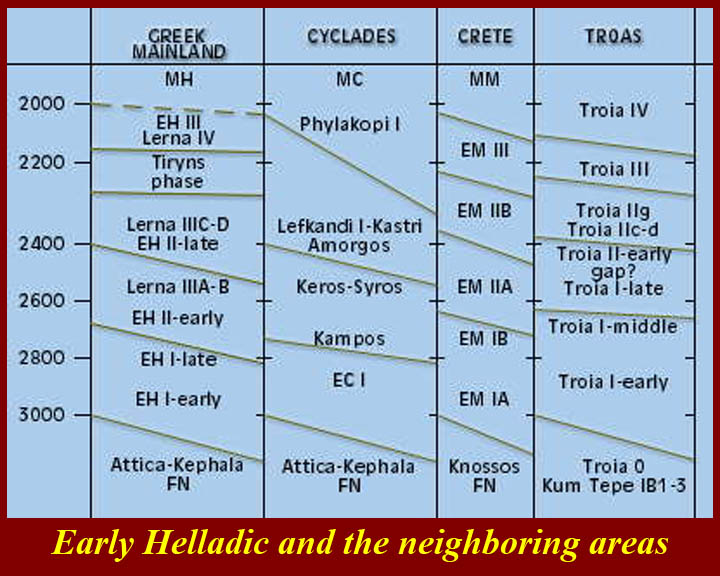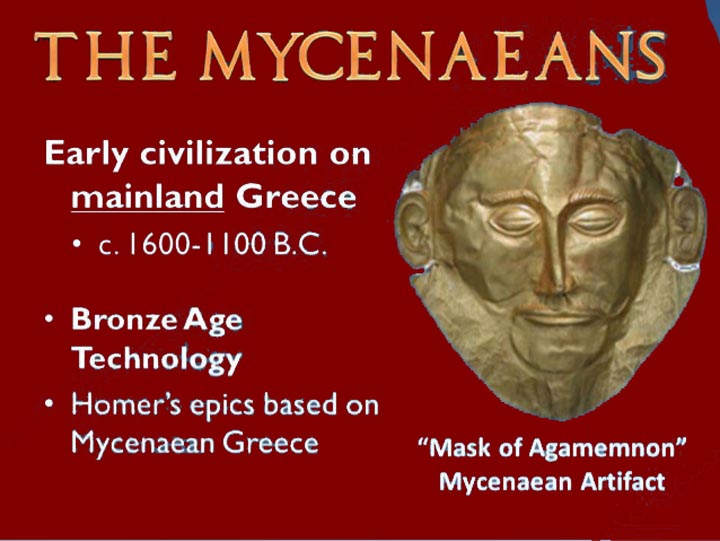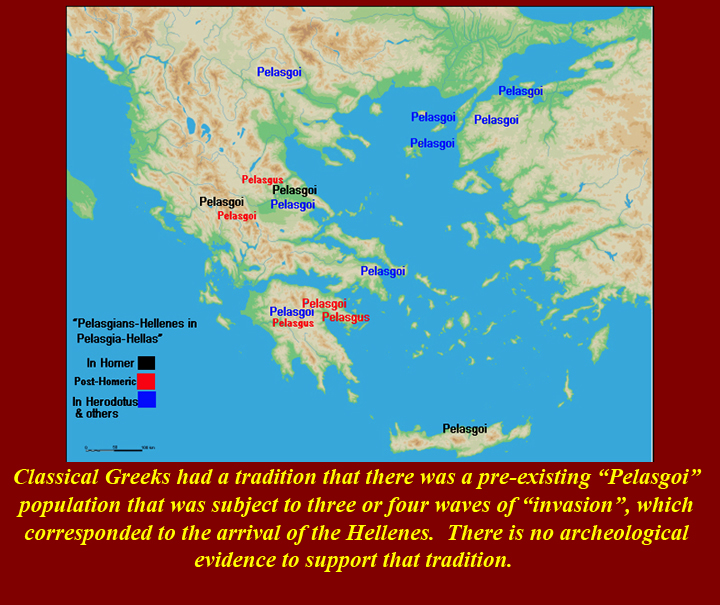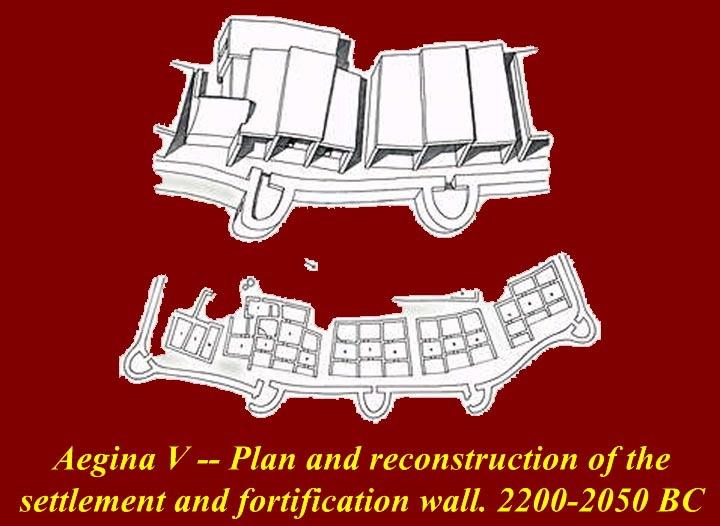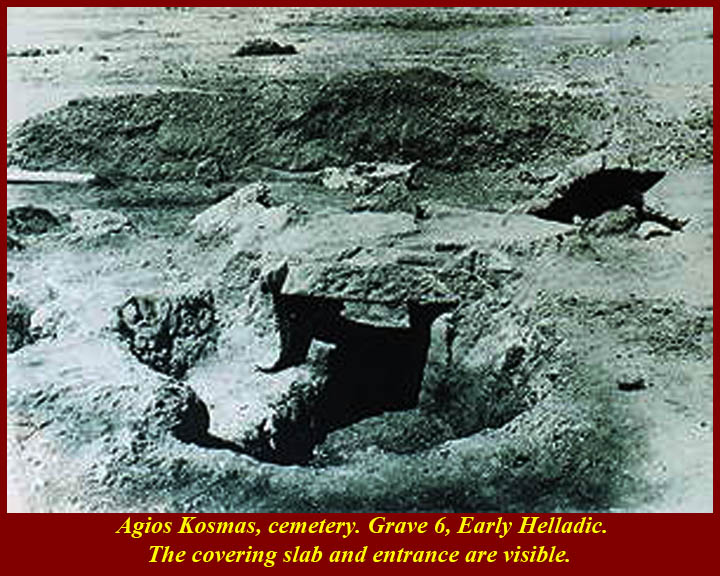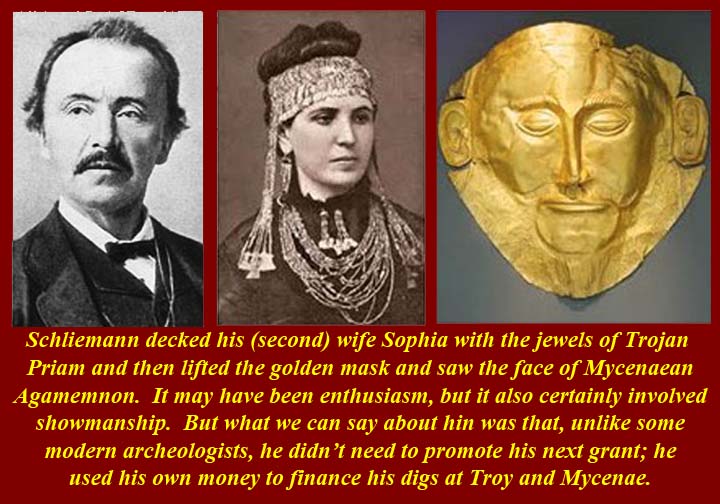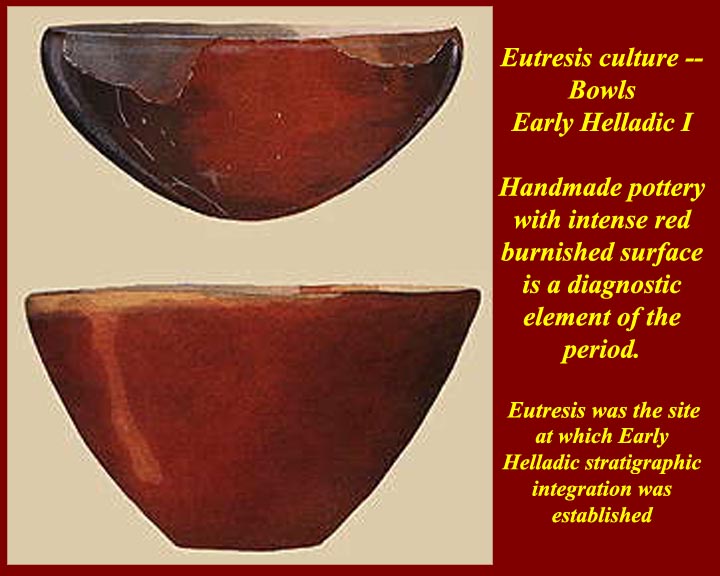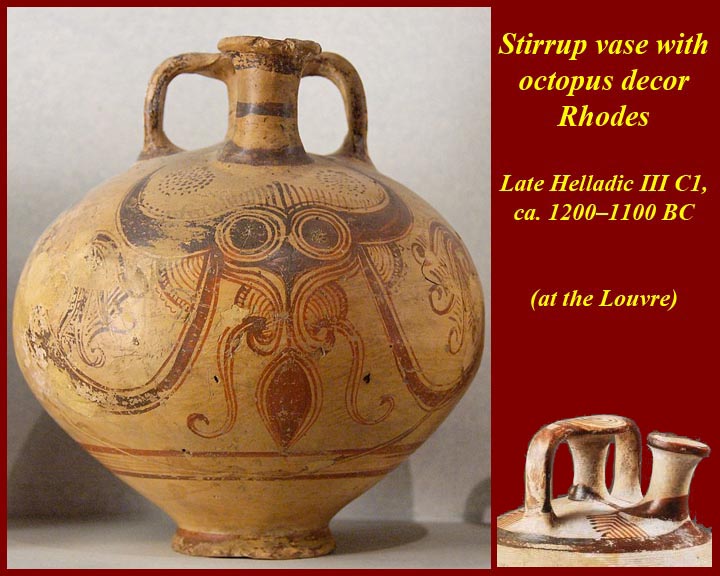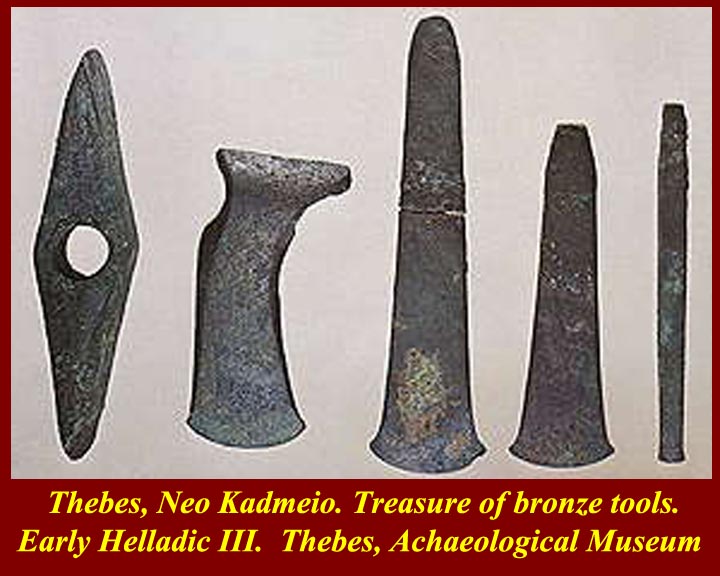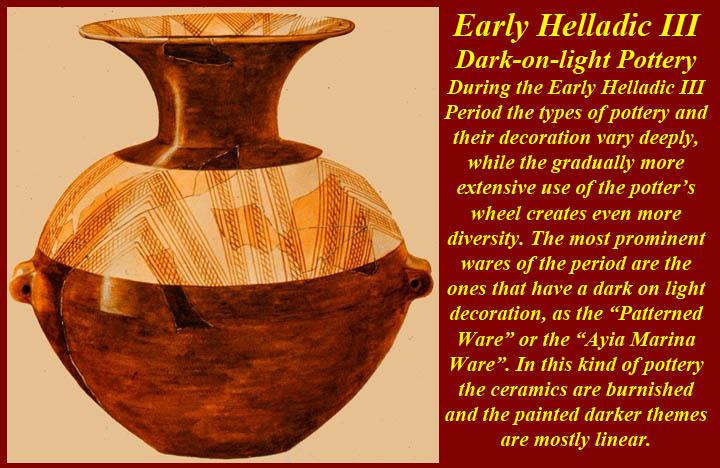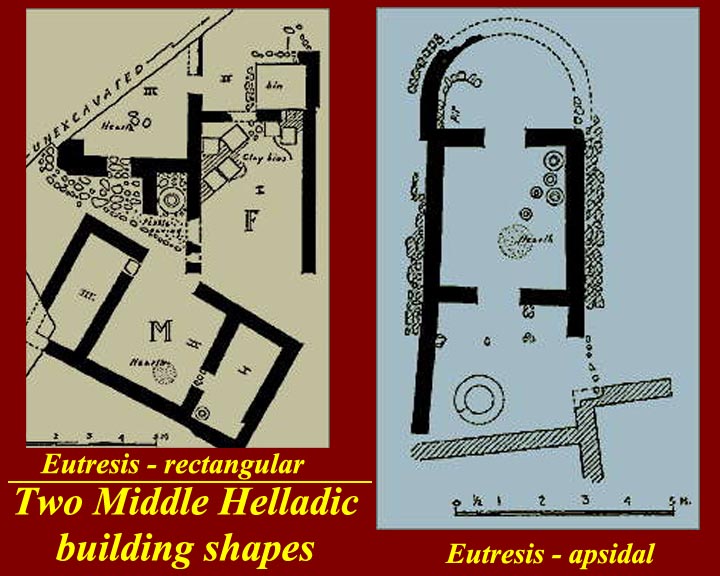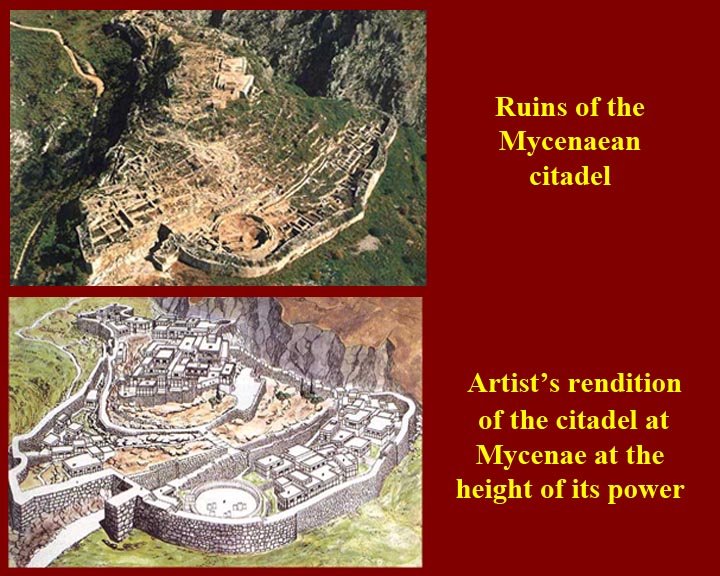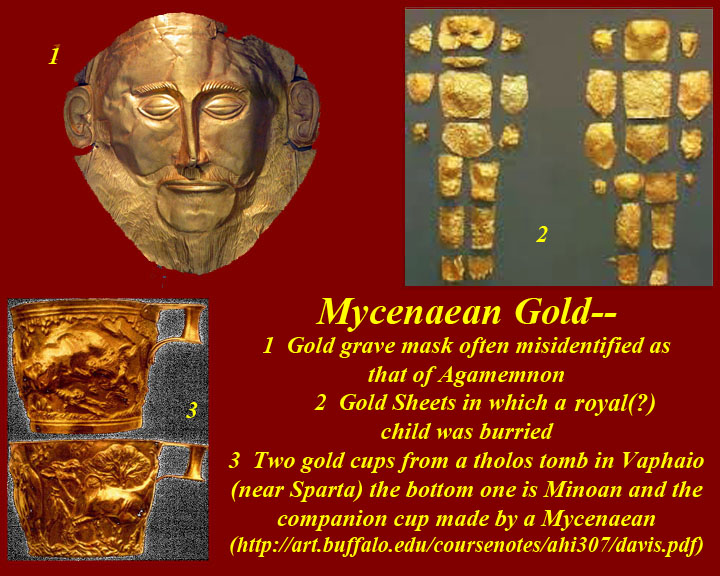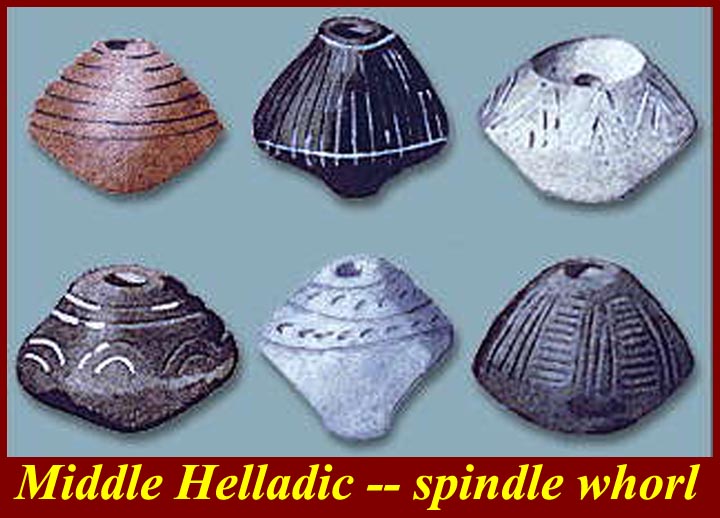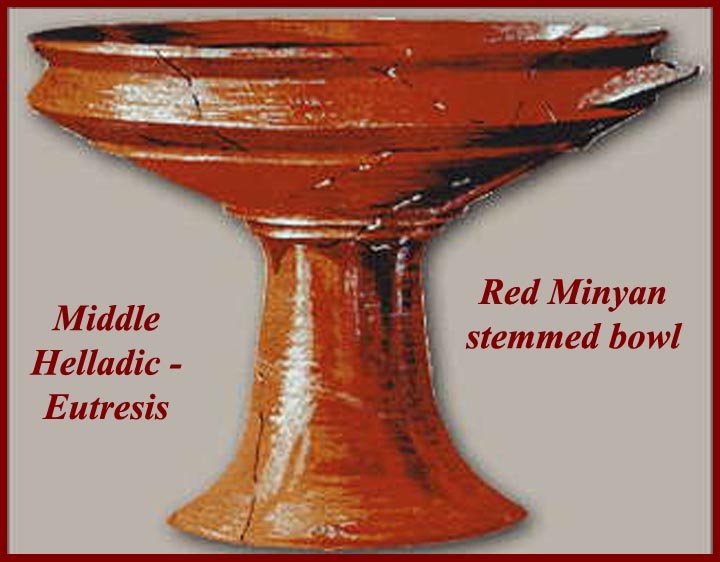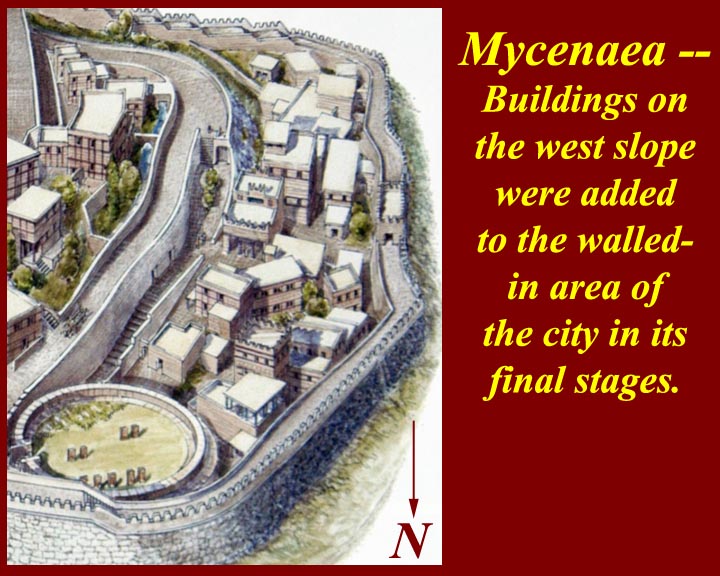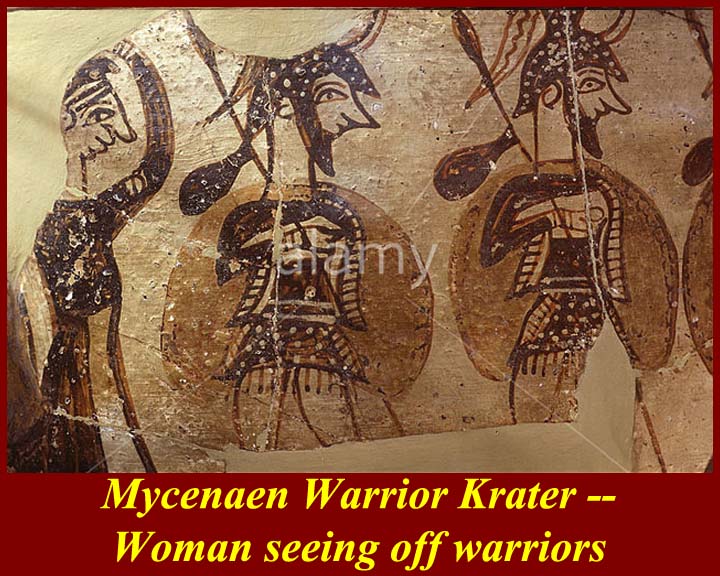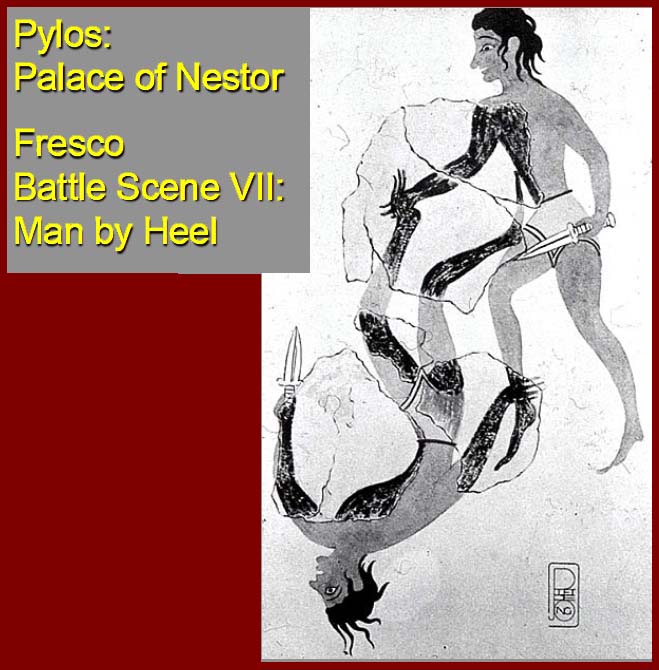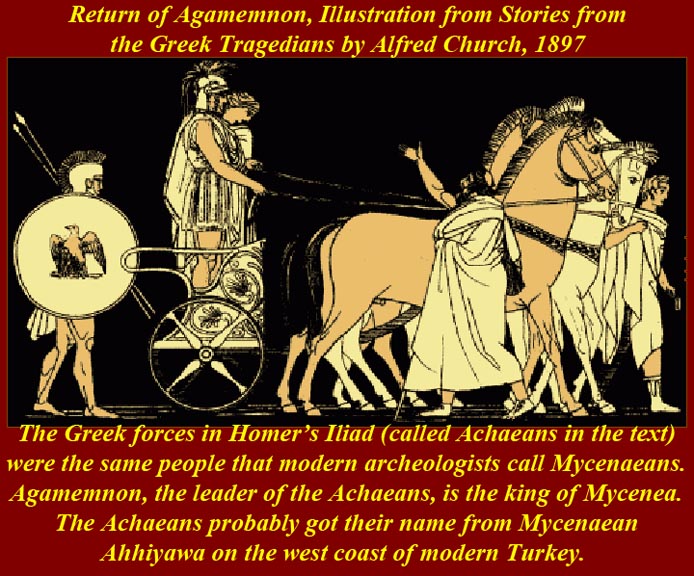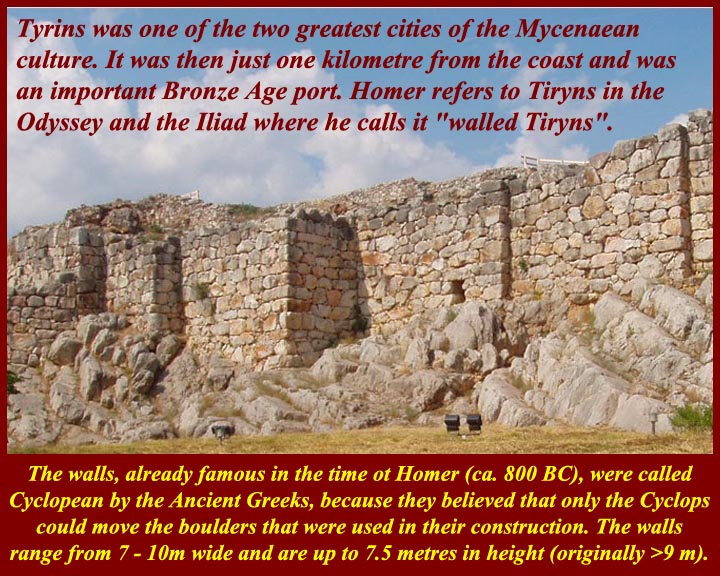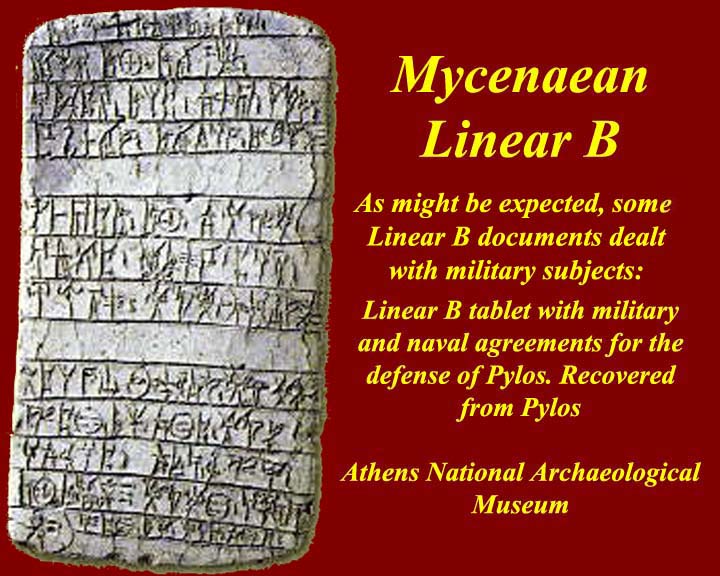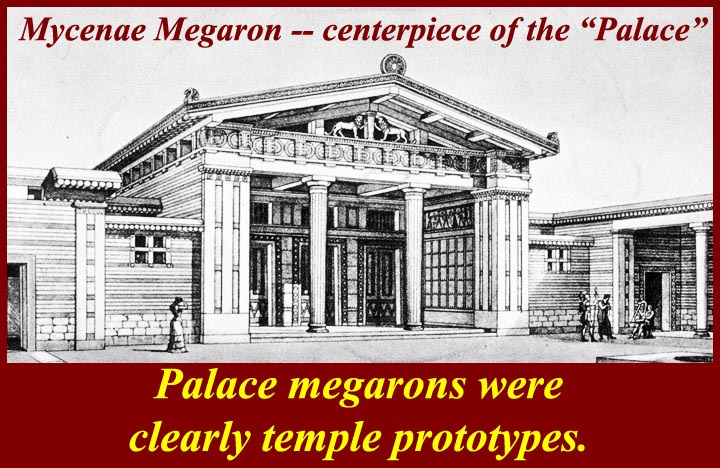Ancient Greece 1
Unit 3 -- The Mycenaeans: Successors to the Minoans and Greek Precursor
(This is a full size image -- clicking on it will not expand it)
The Early Helladic (i.e., mainland Greek) period occurred at the same time as the early Cycladic and Early Minoan periods and with the Troy 0 through Troy IV excavation levels.
(Following are excerpts from https://en.wikipedia.org/wiki/Mycenaean_Greece)
Mycenaean Greece refers to the last phase of the Bronze Age in Ancient Greece (c. 1600–1100 BC). It represents the first advanced civilization in mainland Greece, with its palatial states, urban organization, works of art and writing system. Among the centers of power that emerged, the most notable were those of Pylos, Tiryns, Midea in Peloponnese, Orchomenos, Thebes, Athens in Central Greece and Iolcos in Thessaly. The most prominent site was Mycenae, in Argolid, to which the culture of this era owes its name. Mycenaean and Mycenaean influenced settlements also appeared in Epirus, Macedonia, on islands in the Aegean Sea, on the coast of Asia Minor, the Levant, Cyprus, and Italy.
Mycenaean Greece perished with the collapse of Bronze-Age culture in the eastern Mediterranean. Various theories have been proposed for the end of this civilization, among them the Dorian invasion or activities connected to the “Sea People”. Additional theories such as natural disasters and climatic changes have been also suggested. The Mycenaean period became the historical setting of much ancient Greek literature and mythology, including the Trojan Epic Cycle.
(Following are except from https://en.wikipedia.org/wiki/Mycenae)
Mycenae (/maɪˈsiːni/; Greek: Μυκῆναι Mykēnai or Μυκήνη Mykēnē) is an archaeological site in Greece, located about 90 kilometres (56 miles) southwest of Athens, in the north-eastern Peloponnese. Argos is 11 kilometres (7 miles) to the south; Corinth, 48 kilometres (30 miles) to the north. From the hill on which the palace was located, one can see across the Argolid to the Saronic Gulf.
In the second millennium BC, Mycenae was one of the major centres of Greek civilization, a military stronghold which dominated much of southern Greece. The period of Greek history from about 1600 BC to about 1100 BC is called Mycenaean in reference to Mycenae. At its peak in 1350 BC, the citadel and lower town had a population of 30,000 and an area of 32 hectares (= a square approximately 618.64 yards on each side).
_______________________________________________________________________
Like hybrid roses. the Mycenaeans were nourished by two root stocks. They took beauty from the Minoans (architecture, fresco painting, pottery decoration, metalsmithing) and blended it with the cut-throat traditions of Helladic (i.e., mainland) Greece (knives, swords, spears, bows and arrows, chariots, and, of course walls, walls, walls -- giant Cyclopean walls).
Click on small images to see a larger version.
The Mycenaeans were the Late Helladic (LH) successors of the "Hellenes", a bronze age people of unknown origins descended from a mythological patriarch Hellen, the progenitor of the Greek peoples. (His descendants the Aeolians, Dorians, Achaeans and Ionians correspond to the main Greek tribes and to the main classical dialects spoken in Greece and Asia Minor.) Before the Late Helladic Mycenaeans, there were approximately 1,500 Early Helladic and Middle Helladic years (ca. 3000 BC until 1600 BC).
Early, Middle, and Late are typical unimaginative archeological temporal conventions. Helladic is a term invented to denote mainland Greek stuff; it was a counterpoise for the pre-existing term Cycladic which was used to describe things from the Cyclades islands southeast and south of mainland Greece. That did not, of course, include Crete, which was Minoan. The fourth piece of the Aegean puzzle was Troas with its metropolis Troy on the Turkish Aegean coast, which was also a part of the Hellenic world.
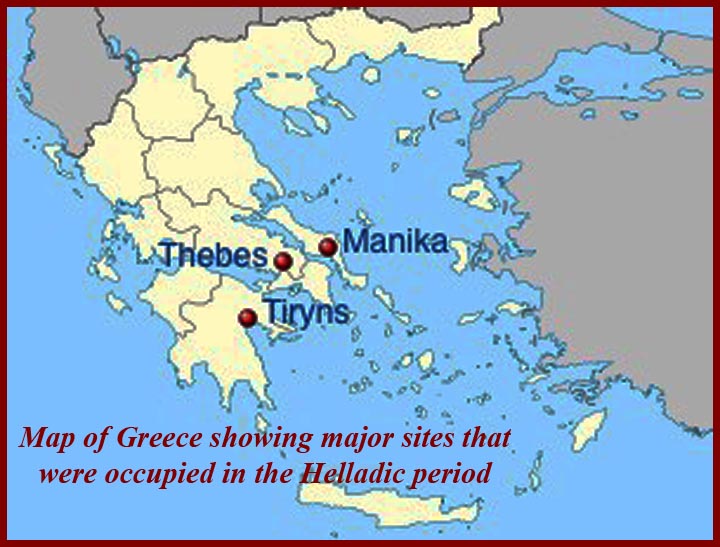
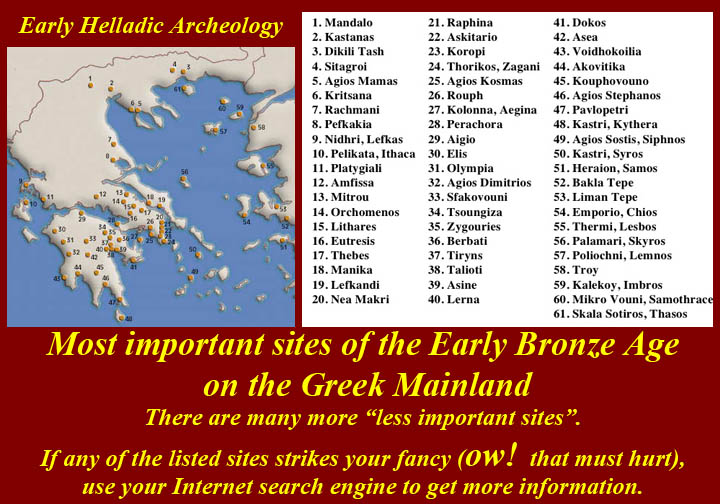
There are dozens of of "Early Helladic" sites in Greece, so called by archeologists to explain the appearance of a seemingly new "culture". Initially they believed "invasion" myths of the Greeks (Homer and others in the Archaic and Classical Periods and, later, Herodotus and his followers). But archeological evidence has never been found to support any real invasions, so now "evolutions" have displaced invasions to support the development of Early, Middle, and Late (Mycenaean) Helladic cultures.
The whole invasion/evolution question may really only be the result of tendentious 19th century Anglo-Saxon (i.e., German and English) translations of Ancient Greek. The Greek words actually implied overthrow (by people who were either out of power or who themselves had previously been ousted) rather than "invasion" by outsiders.
At the time that Greek archeaological terminology was being developed in Germany and England, Western Europe was just exiting the Napoleonic era and entering the 1820 - 1839 colonial expansion period. So it is understandable that archaeologists and learned amateurs like Heinrich Shliemann saw the areas that they were investigating through colonialist lenses. See http://www.mmdtkw.org/GR-Unit3--Mycenaeans.html and scroll down to the Dorian invasion.
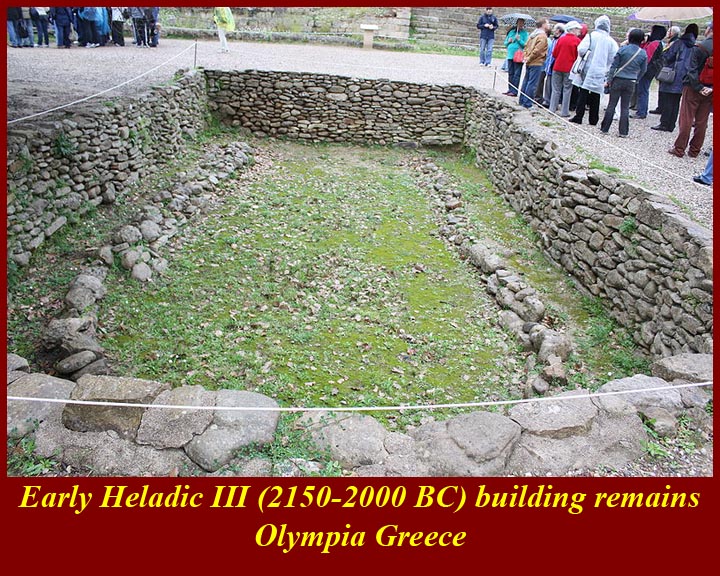
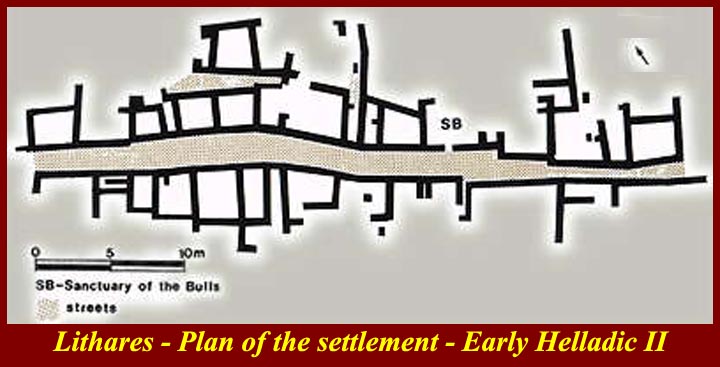
The Early Helladic is mostly an archeologists' construct. There were things on the "Greek" mainland that were transitional between neolithic cultures and the full blown Bronze Age that the early classicists called Middle Helladic -- and Middle Helladic was so named because it corresponded to Middle Cycladic. So anything earlier than Middle Helladic (and wasn't stone age) must perforce be "Early Heladic". Depending on the findspots, "Early Helladic" could be fairly primitive or slightly sophisticated. The important thing was that there was just enough (although sometimes very little) bronze to put the many sites into the the Bronze age. But scientist like classifications and visible divisions of time as well as space. "Early Helladic" is therefore split into phases I, II, and III, and the phases sometimes have "a" and "b" subcategories. All this produces scads of dissertations and reams of publications, much of which finds its way onto the Internet. The advent of modern archeometry (archeological tests and dating technology) make the splitting of the continuum even easier and produces a whole new crop of scads and reams. Some of the more sophisticated sites would probably be better classified as proto-Middle Heladic, but that would not produce a distinct "Early Helladic" academic specialty.
One category that has always fascinated classicists and then, later, scientific archeologists has been burial customs. In Greece were found simple cist graves (holes in the ground) and shaft graves (deeper holes with more complicated coverings). Sometimes they were grouped together in "Grave Circles" (what the rich did in family groups -- we would call them family plots) and sometimes the circles would be under beehive-shaped stone structures that would be mounded over with earth. As time went on, everything got more sophisticated and complex, especially for the rich and famous, But time went on at different places at varying rates. Sometimes time never "went on" at all, and simpler primitive methods seemed to last forever. Once again, archeometry has resolved some questions of age, but it only has proved that various burial methods coexisted according to place, time, and class. As we go along we will see that the dig-meisters, especially the early ones, looked predominantly for and at ancient people of their own class and the class of their sponsors and institutions, and that they classified their finds accordingly. More on burials later.
Especially the early diggers, and Heinrich Schliemann not the least, routinely overstated who and what they found. Priam's Gold belonged to an earlier someone else, and so did Agamemnon's Mask.
This red burnished Eutresis bowl of the type that was an important diagnostic tool used to integrate the Early Helladic Period between the Neolithic and Middle Helladic on mainland Greece. You can find the 1958 report of supplementary excavations of Eutresis by Hetty Goldman, the original 1924-1927 investigator, on the Internet at http://www.ascsa.edu.gr/pdf/uploads/hesperia/147291.pdf. (40 pages of text with drawings and 14 subdivided photographic plates.)
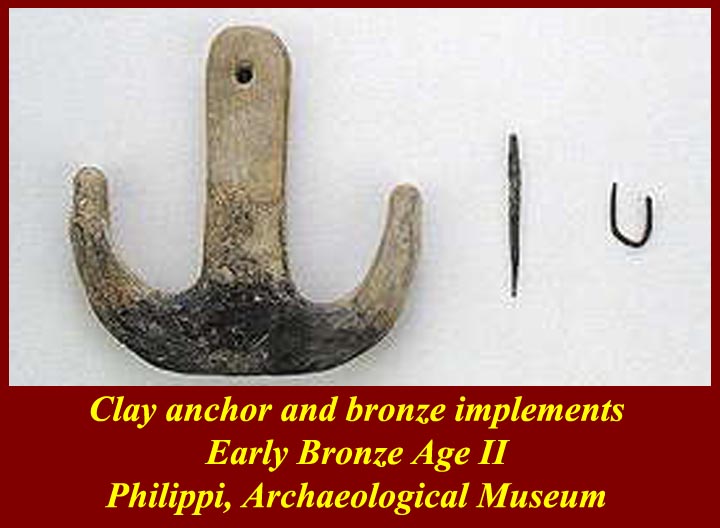
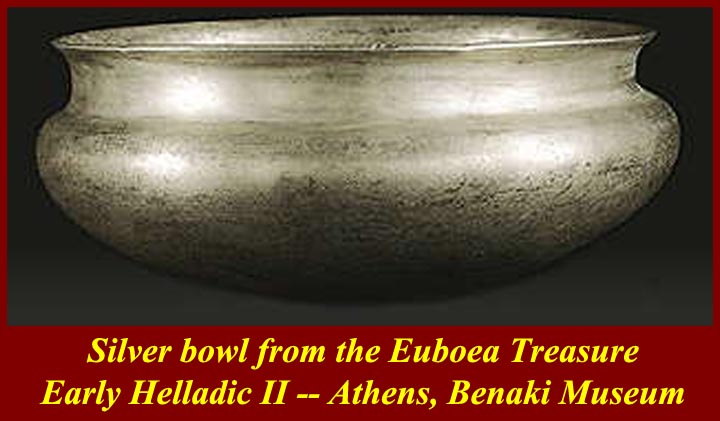
Bronze finds in the Early Helladic were few and sparce. Evidence of when bronze making technology entered the Helladic area is easy -- right after the Greek mainland Neolithic is definitive, and that was about 5000 years ago. The route of the technology's entrance is unknown.
The archaeological site of Belovode on the Rudnik mountain in Serbia contains the world's oldest securely dated evidence of copper making at high temperature, from 5,000 BC. (From https://en.wikipedia.org/wiki/Chalcolithic)
The discovery of bronze (mostly copper alloys -- usually ten copper to one other metal ) enabled people to create metal objects which were harder and more durable than previously possible. Bronze tools, weapons, armor, and building materials such as decorative tiles were harder and more durable than their stone and copper ("Chalcolithic") predecessors. Initially, bronze was made out of copper and arsenic, forming arsenic bronze, or from naturally or artificially mixed ores of copper and arsenic, with the earliest artifacts so far known coming from the Iranian plateau in the 5th millennium BCE. It was only later that tin was used, becoming the major non-copper ingredient of bronze in the late 3rd millennium BC
Tin bronze was superior to arsenic bronze, because the alloying process could be more easily controlled, and the resulting alloy was stronger and easier to cast. Also, unlike arsenic, metallic tin and fumes from tin refining are not toxic. The earliest tin-alloy bronze dates to 4500 BCE in a Vinča culture site in Pločnik (Serbia). Other early examples date to the late 4th millennium BC in Africa, Susa (Iran), and some ancient sites in China, Luristan (Iran) and Mesopotamia (Iraq). (From https://en.wikipedia.org/wiki/Bronze).
By the Middle Helladic, silver and gold vessels and ornaments were being produced locally and imported. Design was often copied from Minoan examples.
The "Stirrup jar" named for its stirrup- shaped top handle, is often associated with the Helladic because its shape catches the eye and the imagination. It's actually a Cretan, Minoan or perhaps sub-Minoan, invention. And remember that sub-Minoan really means the period after the tsunamis knocked down the Minoans and the period during which the Mycenaeans were taking over Crete, i.e., the time when the Late Helladic was spreading to Crete.
Although we may never know when the first Bronze Age technologies and arts came to mainland Greece, it is very clear that everything got a big boost when the Mycenaeans inherited everything after the tsunami destruction of Minoan Crete. Although there is not a single date for the takeover of Crete we can fairly closely time of the Minoan end to around 1600 BC. After a short Sub-Minoan period, Crete along with everything else in the Aegean area became Mycenaean. (A prime example of Mycenaean conquest was sung by "Homer" in the Illiad -- around 850 BC, according to Herodotus).
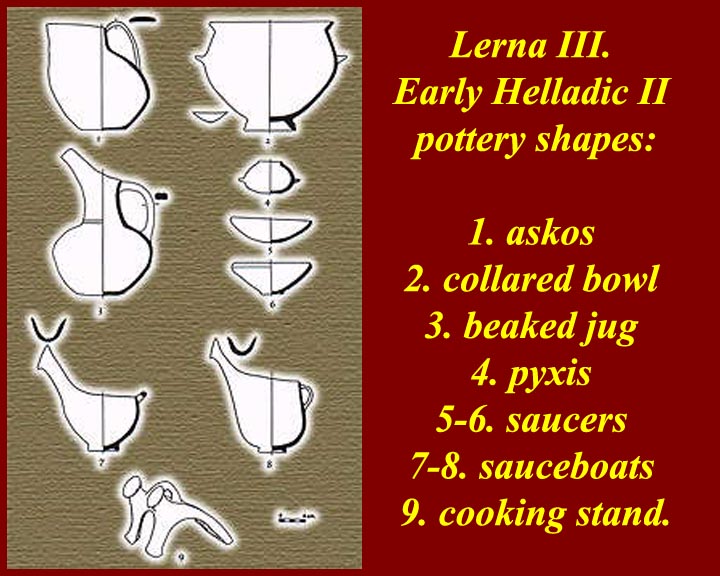
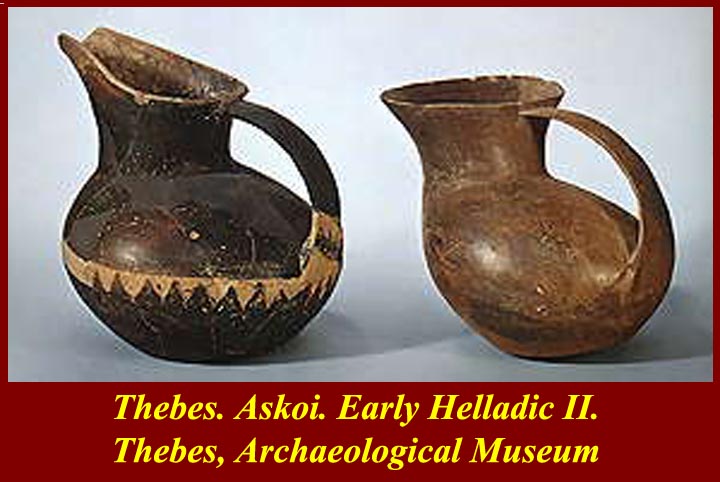
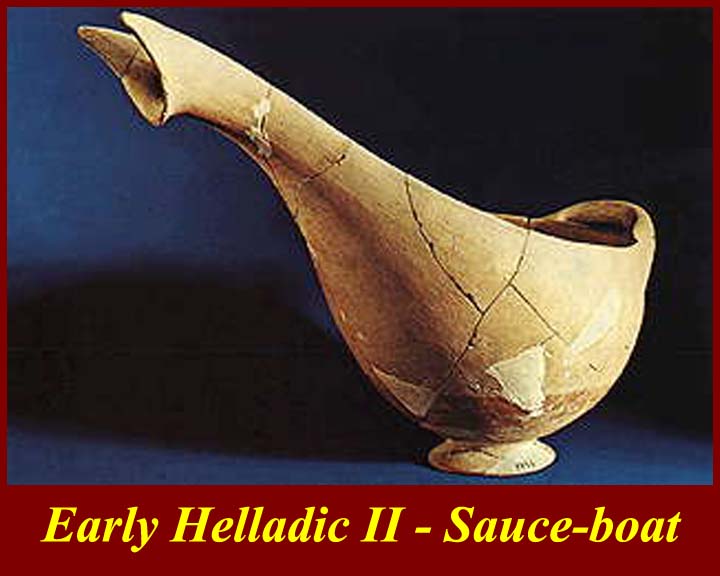
Mycenaen pottery shapes, sizes, and decorations proliferated about the same time that commercial contact with the Minoan culture (mostly instigated by the Minoans, who for years exported pottery to the mainland. The continuity between Minoan and Mycenaean potteries is so strong that only highly technical archeometry can determine the origin of the pottery (by determining the location from whence came the clays and slips).
Building sizes, shapes, and purposes varied considerably over time and place. Both of the houses in this image actually came from the same time and town. It appears to have been a matter of taste--but that, of course could have been affected by class, wealth, family tradition, relative religiosity, etc. Or maybe not.
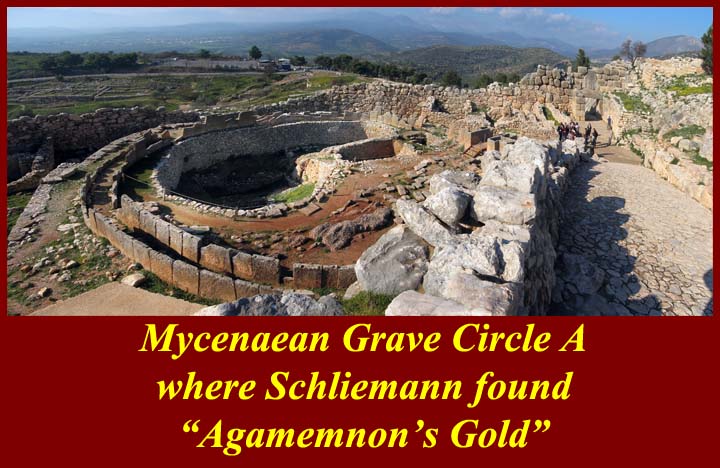
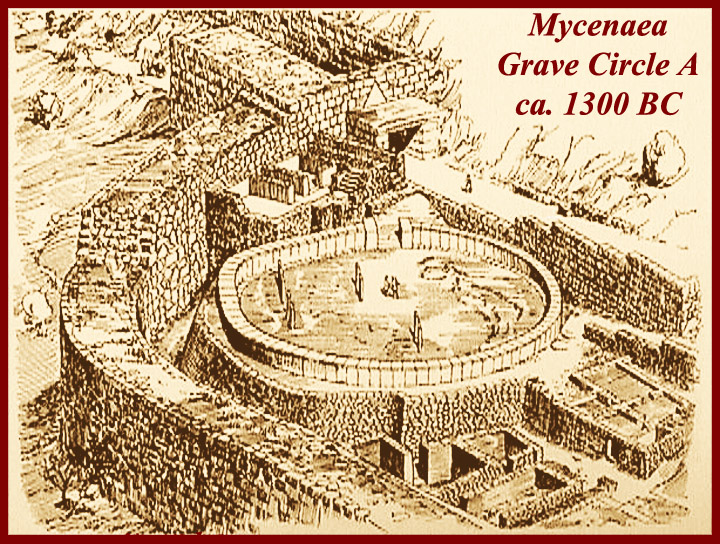
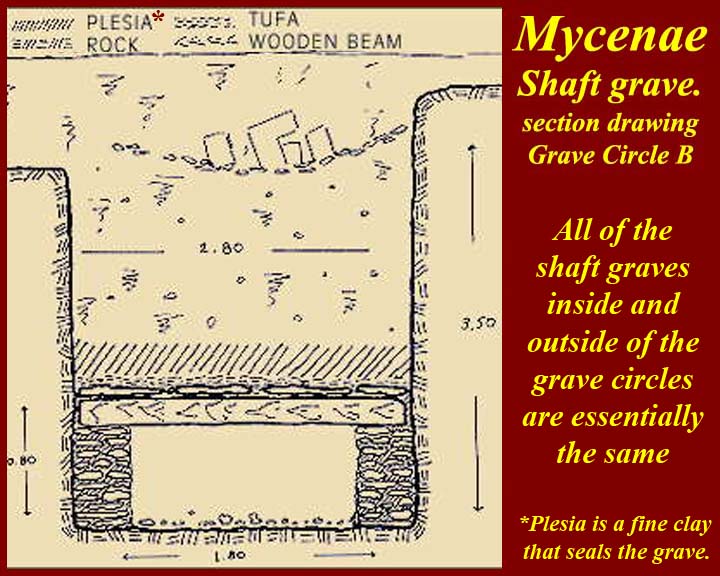
From https://en.wikipedia.org/wiki/Grave_Circle_A,_Mycenae where there more on the site.
Grave Circle A in Mycenae is a 16th-century BC royal cemetery situated to the south of the Lion Gate, the main entrance of the Bronze Age citadel of Mycenae, southern Greece.[1] This burial complex was initially constructed outside the fortification walls of Mycenae, but was ultimately enclosed in the acropolis when the fortifications were extended during the 13th century BC. Grave Circle A and Grave Circle B, the latter found outside the walls of Mycenae, represent one of the major characteristics of the early phase of the Mycenaean civilization.
The circle has a diameter of 27.5 m (90 ft) and contains six shaft graves, where a total of nineteen bodies were buried. It has been suggested that a mound was constructed over each grave, and funeral stelae were erected. Among the objects found were a series of gold death masks, additionally beside the deceased were full sets of weapons, ornate staffs as well as gold and silver cups. The site was excavated by the archaeologist Heinrich Schliemann in 1876, following the descriptions of Homer and Pausanias. One of the gold masks he unearthed became known as the "The Death Mask of Agamemnon", ruler of Mycenae according to Greek mythology. However, it has been proved that the burials date circa three centuries earlier, before Agamemnon is supposed to have lived.
See also https://en.wikipedia.org/wiki/Grave_Circle_B,_Mycenae.
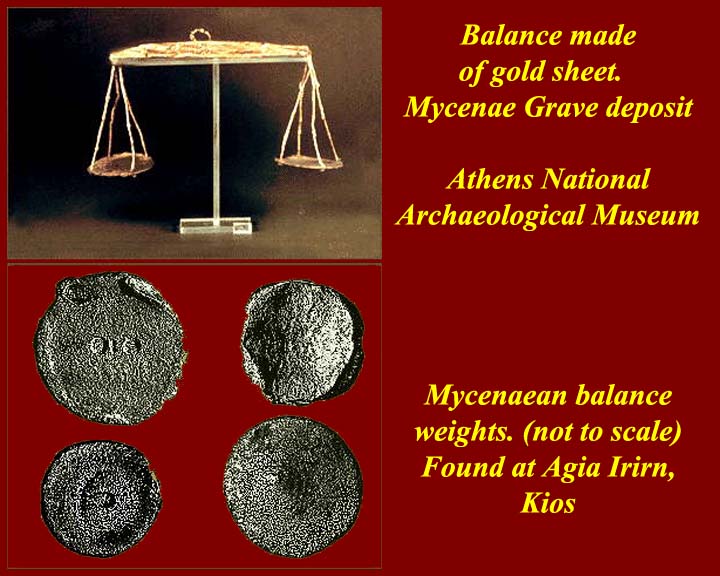
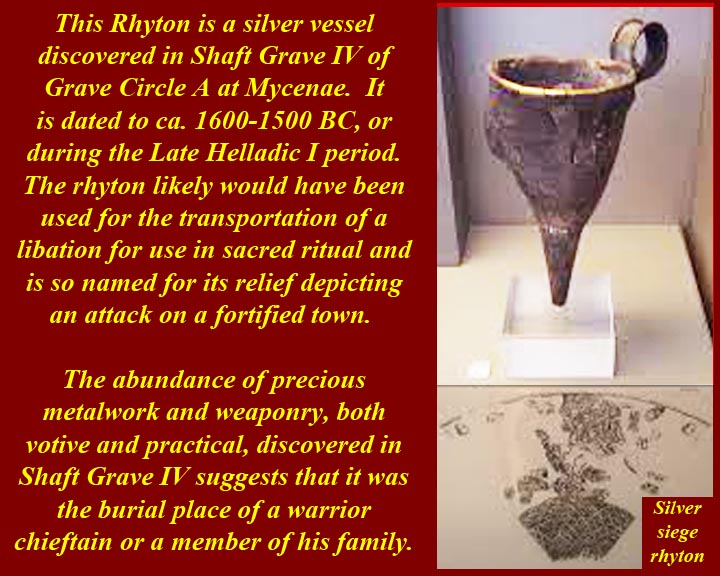
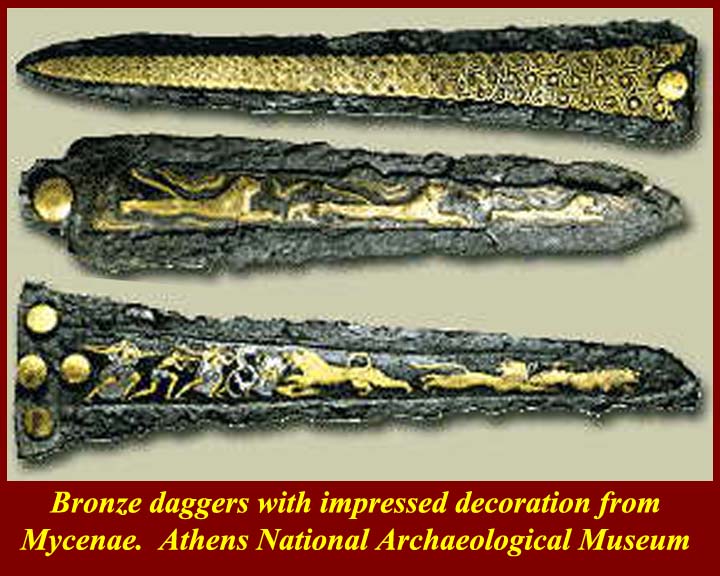
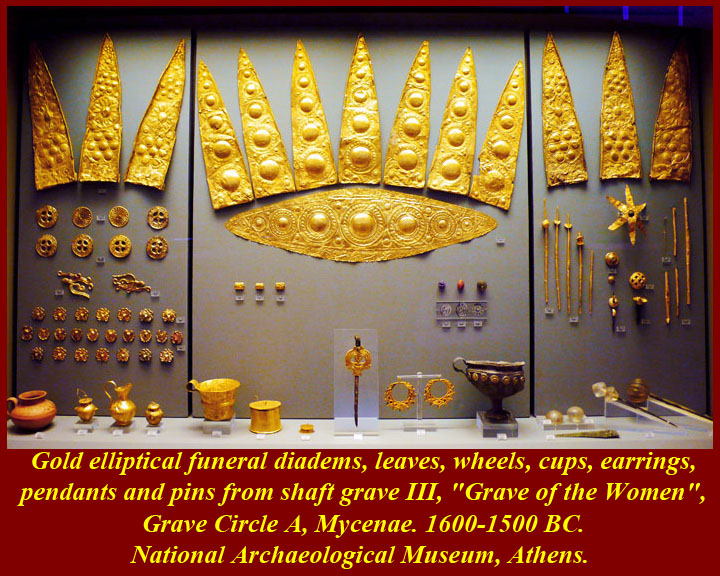
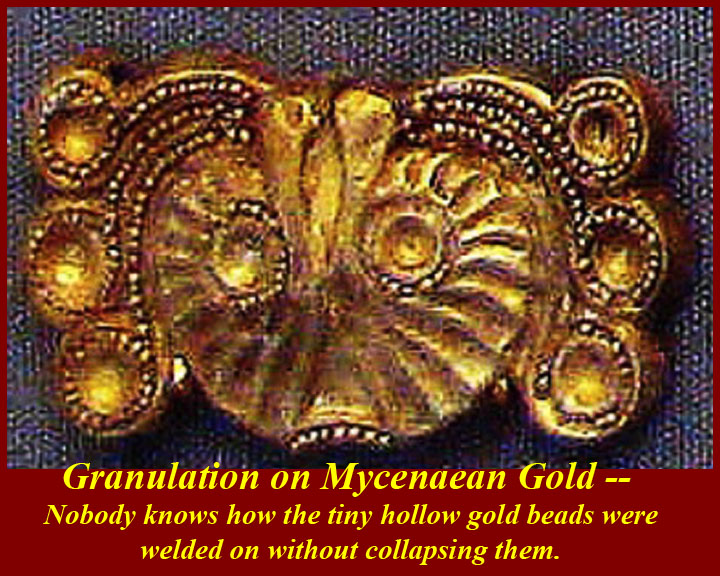
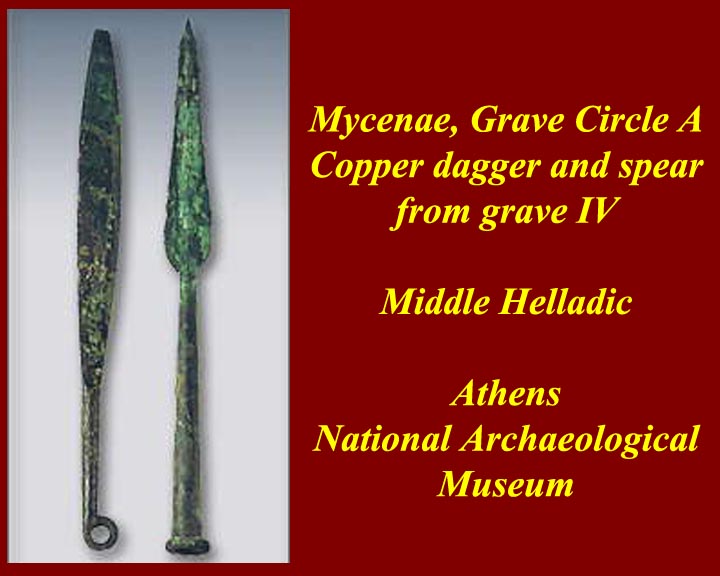
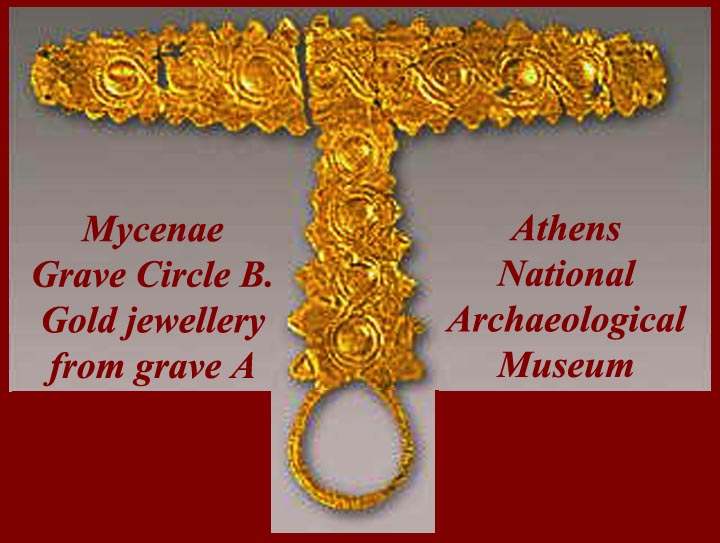
The Mycenaean Grave Circles yielded a wealth (exactly the right word) of gold and silver decorations and artifacts. To see much more, use the Google image search function (https://images.google.com) to search for the following word sequence: grave circle artifacts mycenae.
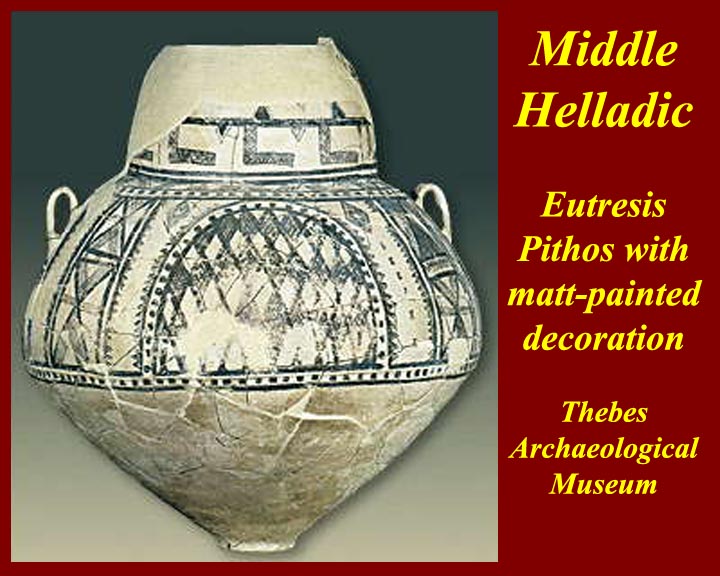
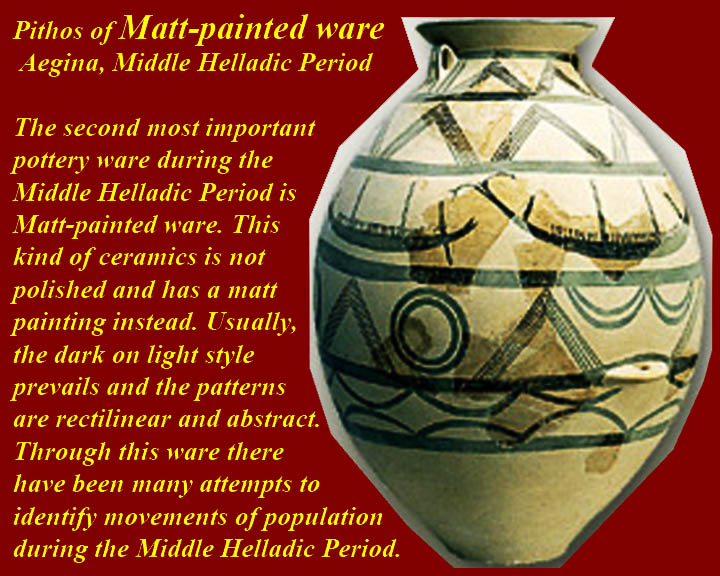
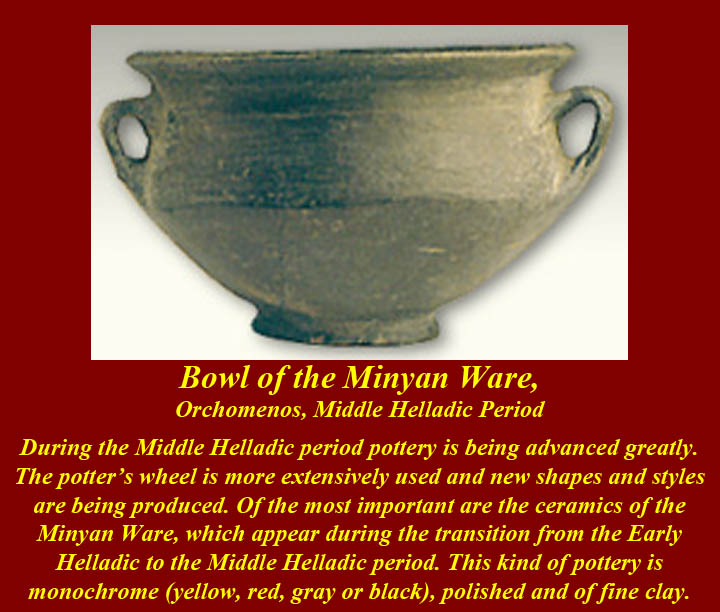
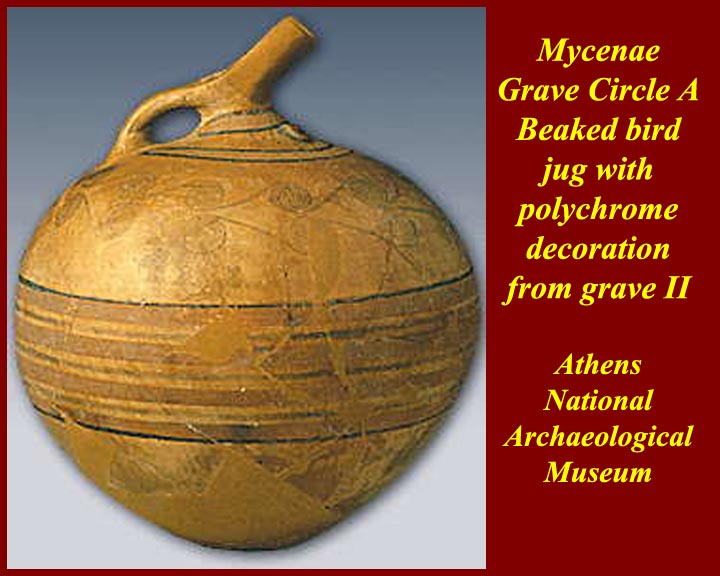
Some pottery styles became characteristically Mycenaean: matt painted ware and Minyan ware were found at many sites around mainland Greece.
For information on matt-painted pottery, see http://www.aegeobalkanprehistory.net/article.php?id_art=8.
For information on Munyan ware, see https://en.wikipedia.org/wiki/Minyan_ware.
See above for a link to Eutresis excavations.
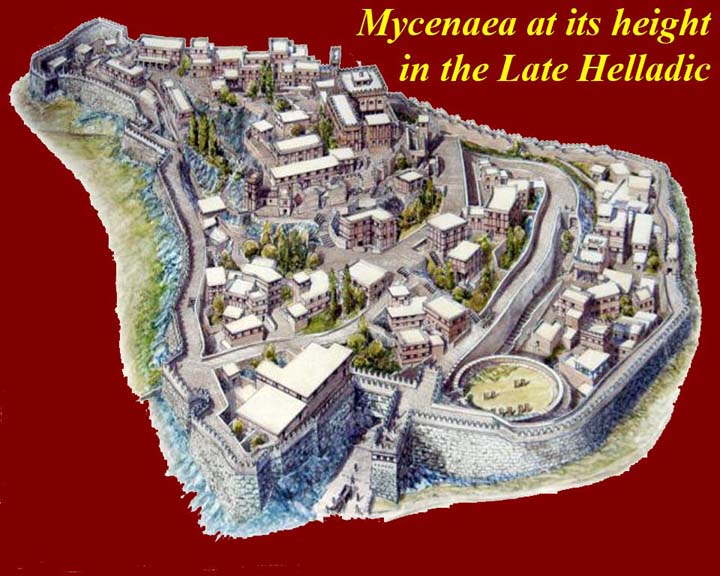
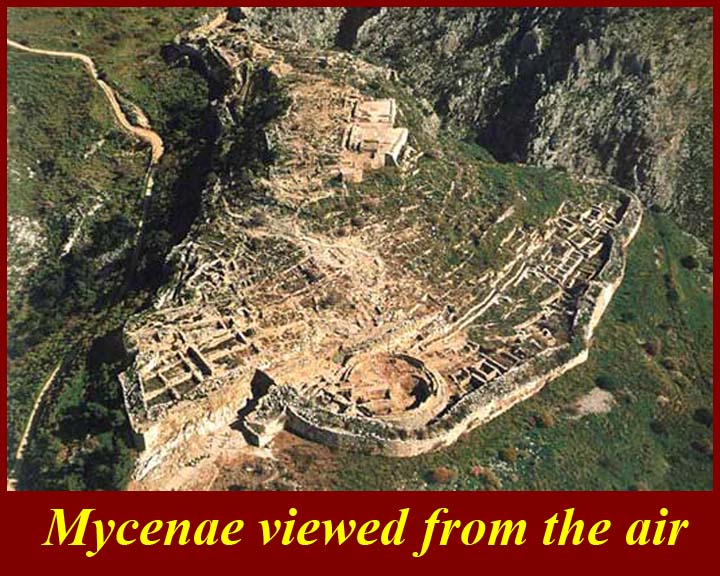
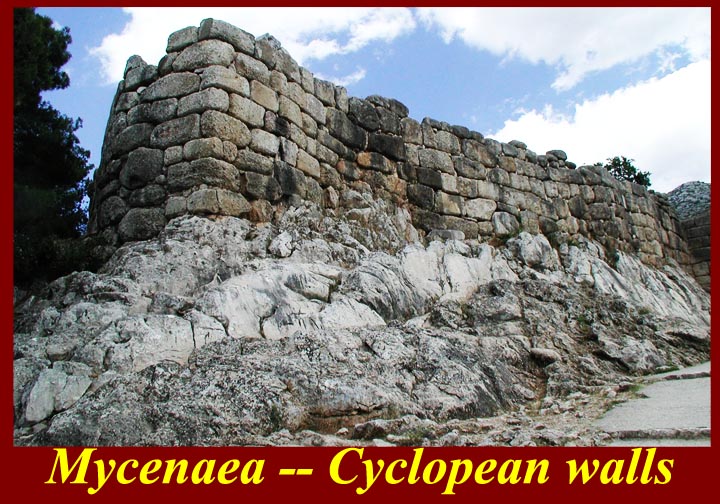
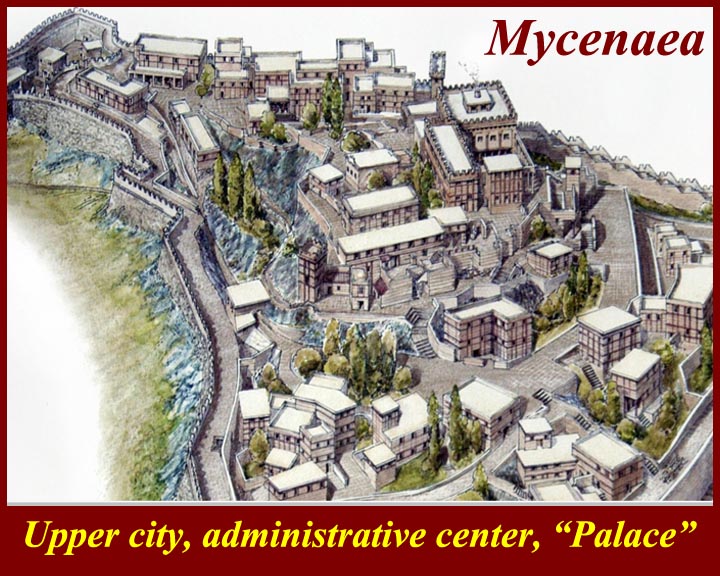
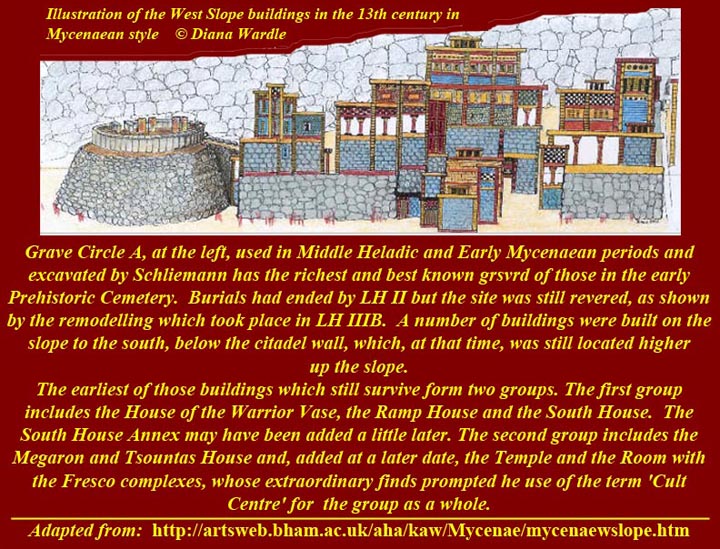
Mycenae in its stage of full development. At the top of the city was the "palace" -- administrative, cult, and residential center for the city and for the ruling family ("king" and court). The lower city inside the extended western walls included another apparent religious area labled by archeologists as a cult center.
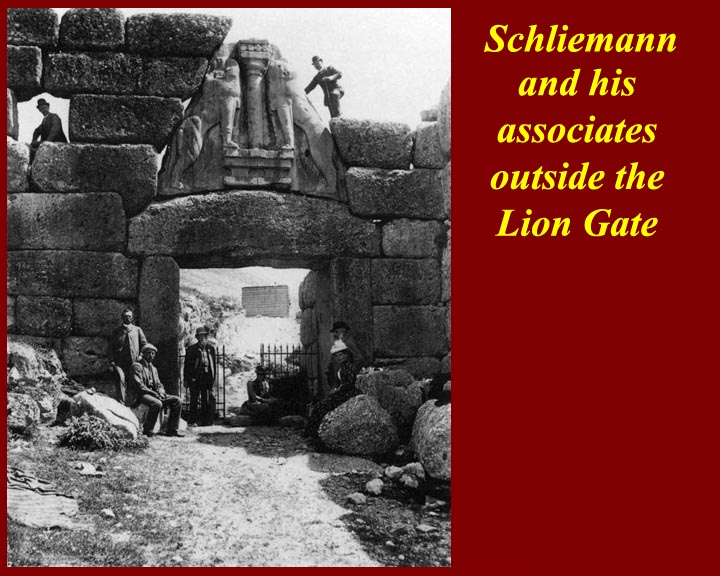
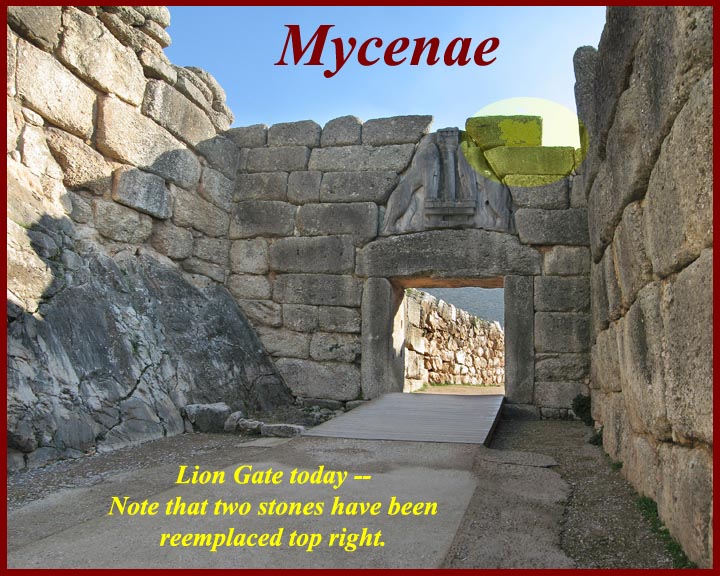
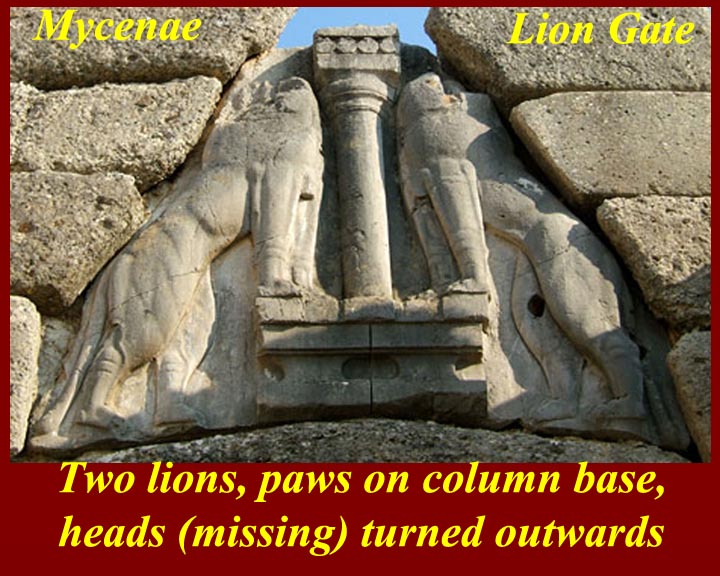
The Lion Gate was the main entrance of the Bronze Age citadel of Mycenae, southern Greece. It was erected during the 13th century BC in the northwest side of the acropolis and is named after the relief sculpture of two lionesses in a heraldic pose that stands above the entrance. The Lion Gate is the sole surviving monumental piece of Mycenaean sculpture, as well as the largest sculpture in the prehistoric Aegean. (From https://en.wikipedia.org/wiki/Lion_Gate, where ther is more information on the Gate.)
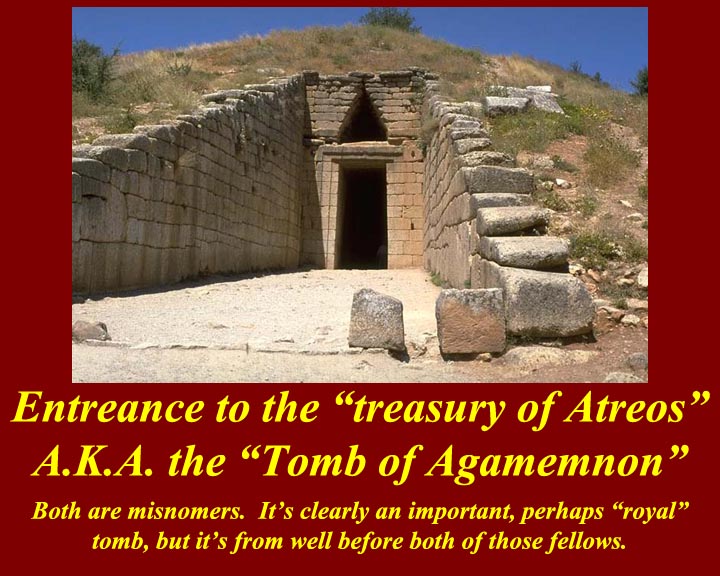
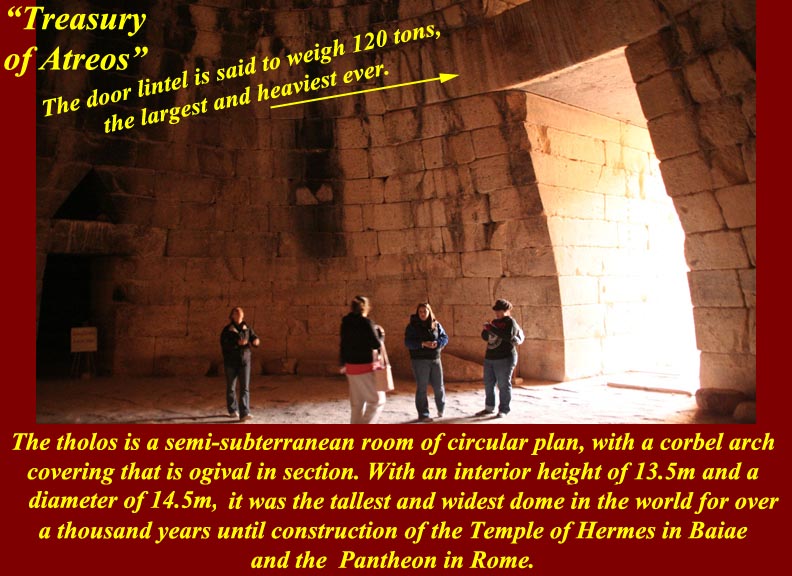
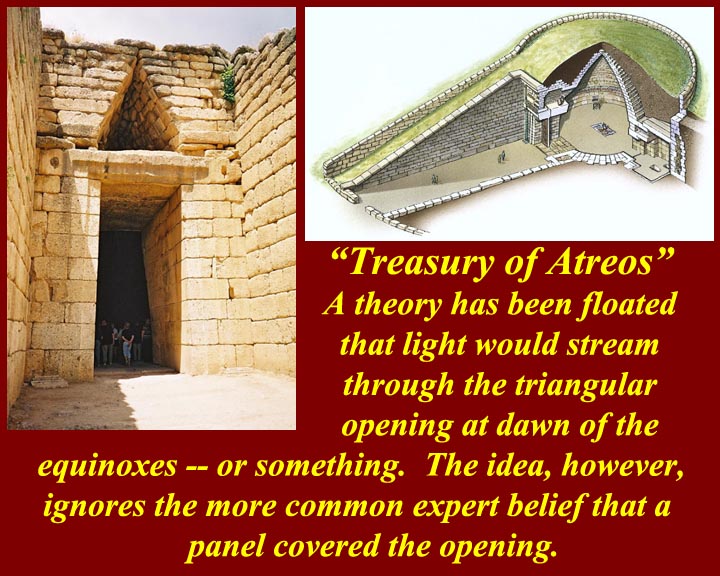
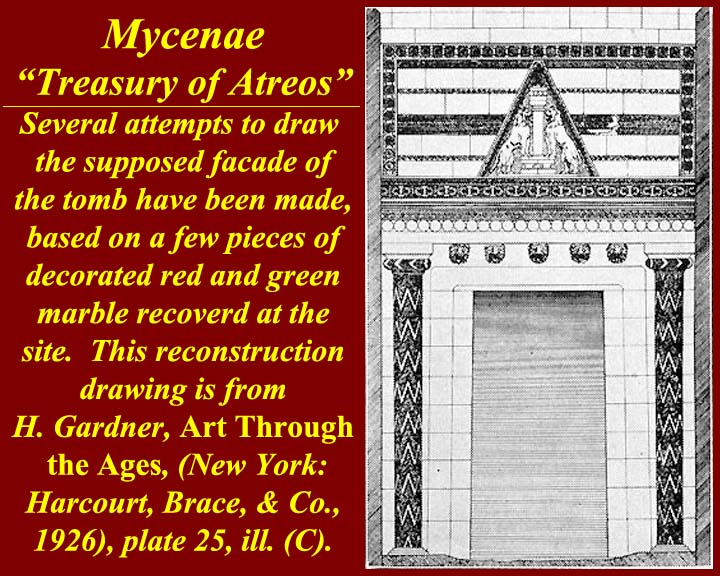
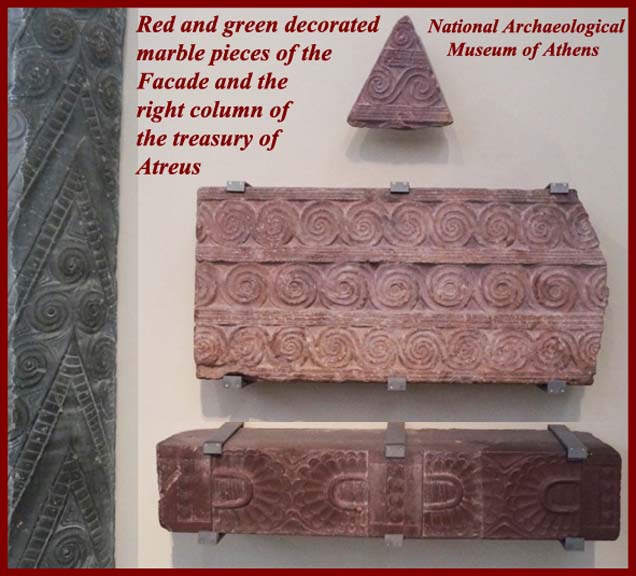
The "Treasury of Atreus" also known as the "Tomb of Agamemnos" is neither a treasury nor was it Agamemnon's tomb. It is, however an impressive "tholos" tomb constructed during the Bronze Age around 1250 BC. The lintel stone above the doorway weighs 120 tons, with approximate dimensions 8.3 x 5.2 x 1.2m, the largest in the world. The tomb was used for an unknown period. Mentioned by Pausanias, it was still visible in 1879 when the German archeologist Heinrich Schliemann discovered the shaft graves under the 'agora' in the Acropolis at Mycenae. The tomb has probably no relationship with either Atreus or Agamemnon, as archaeologists believe that the sovereign buried there ruled at an earlier date than the two; it was named thus by Heinrich Schliemann and the name has been used ever since. See https://en.wikipedia.org/wiki/Treasury_of_Atreus.
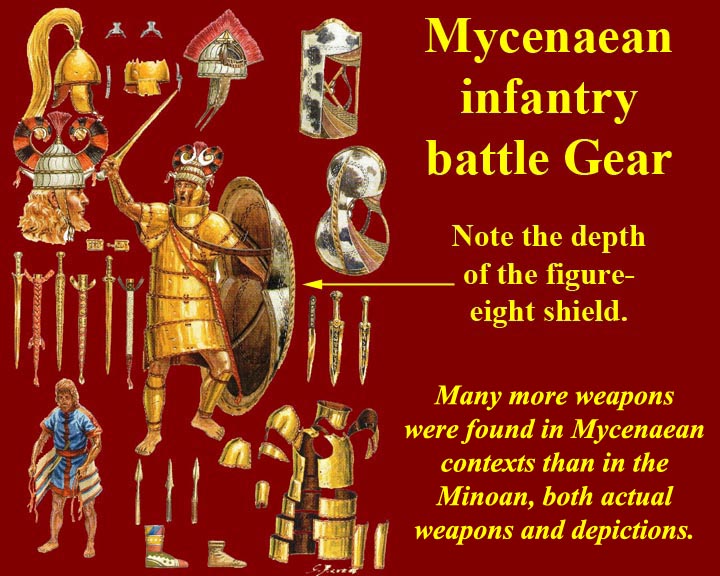
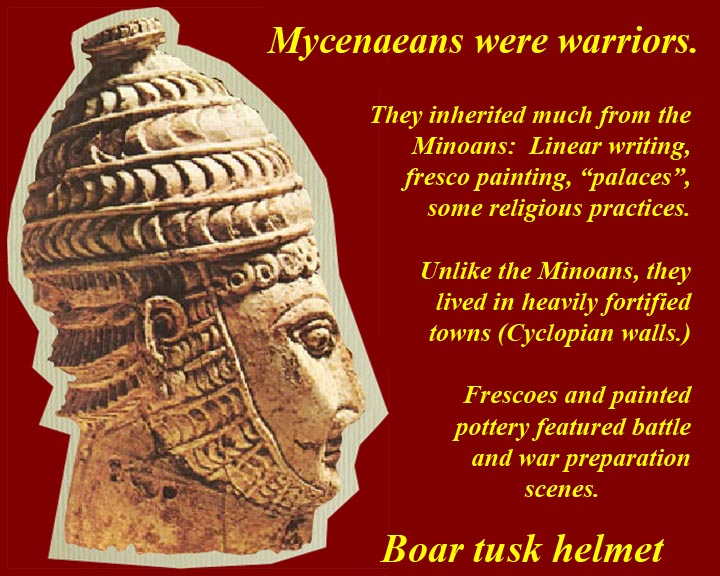
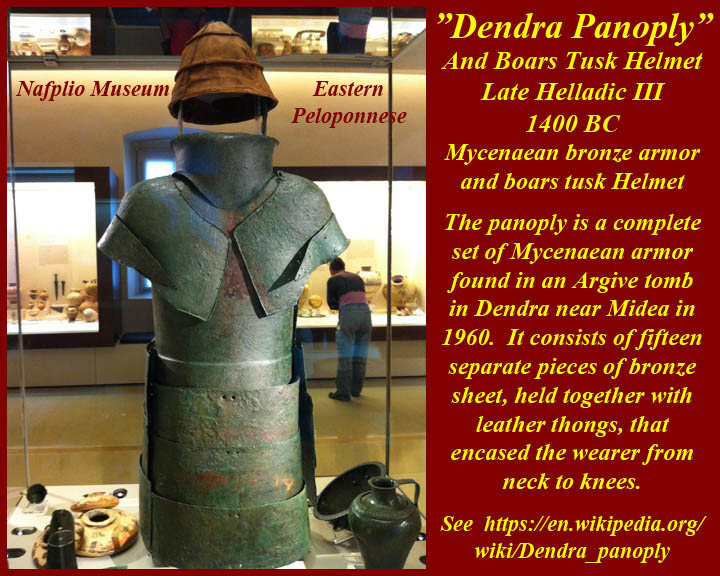
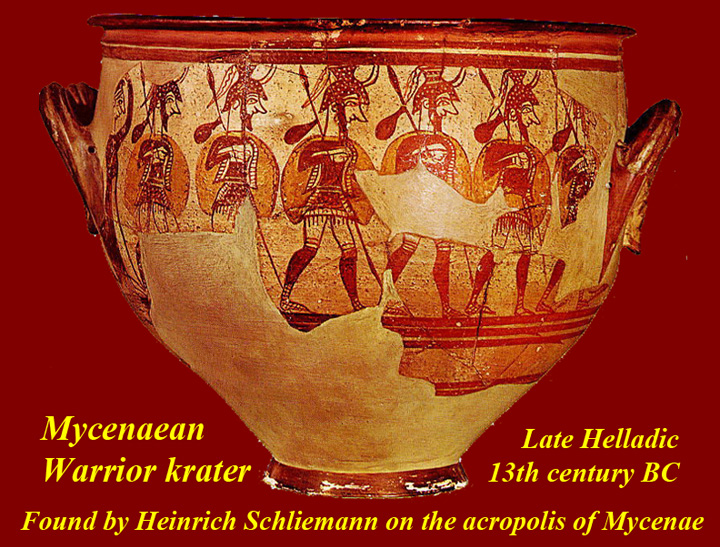
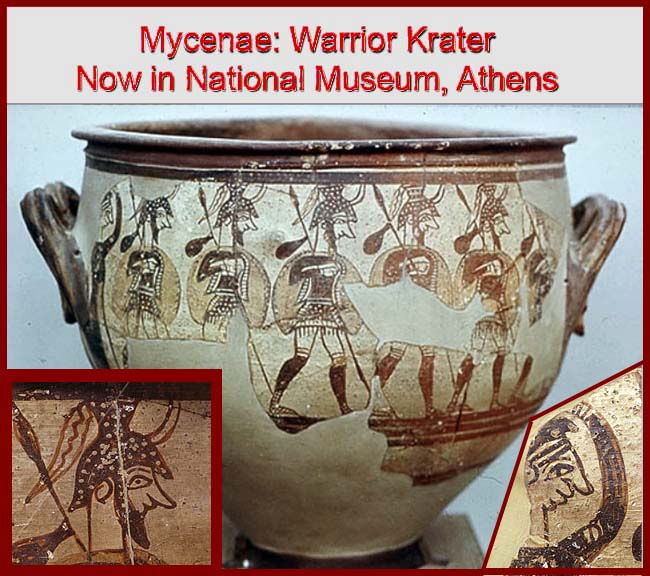
As noted above, a major difference between the Mycenaeans and the Minoans was the warlike propensities of the former.
Compare the joyous singing farmers on the Minoan Harvester vaseto the grim warfighter on the Warrior Krater of the Mycenaeans.
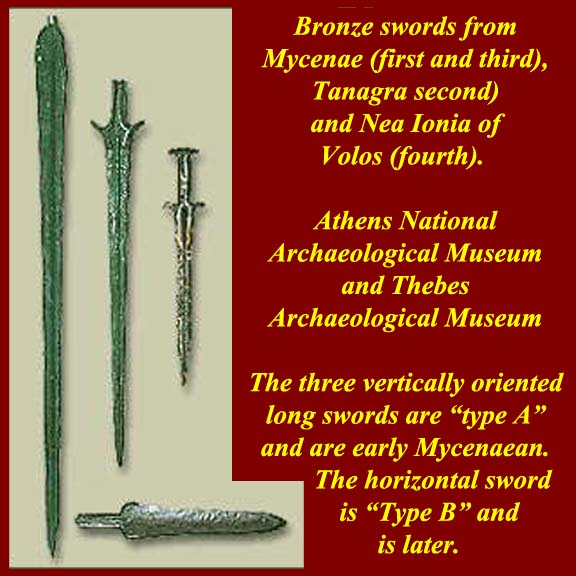
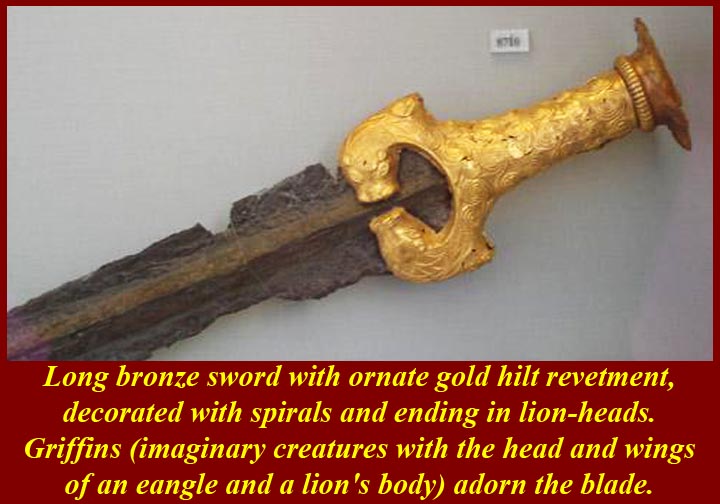
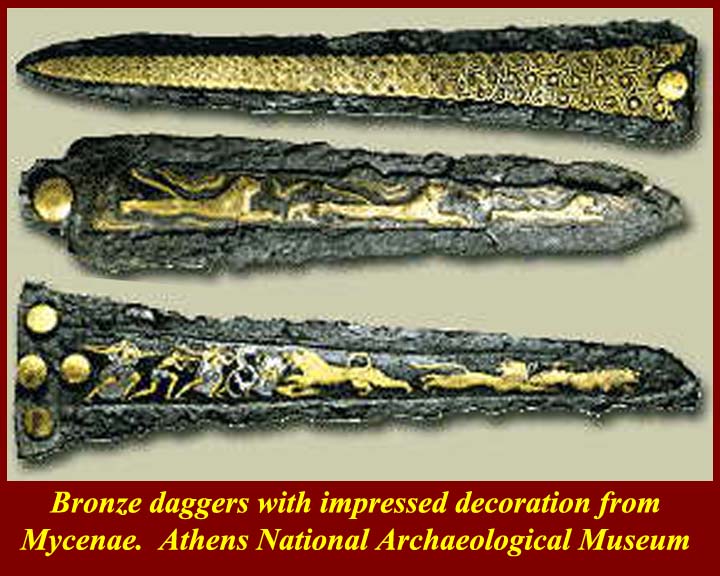
Many, many bronze blade weapons -- and depictions of the use of blade weapons -- in every Mycenaean site. Minoans also had blades but they were depicted in ceremonies rather than in wars. And the Mycenaeans did, in fact, dominate the whole Aegean. And Agamemnon, the supposed King of the Mycenaeans, was chosen by his peers to lead the Trojan War.
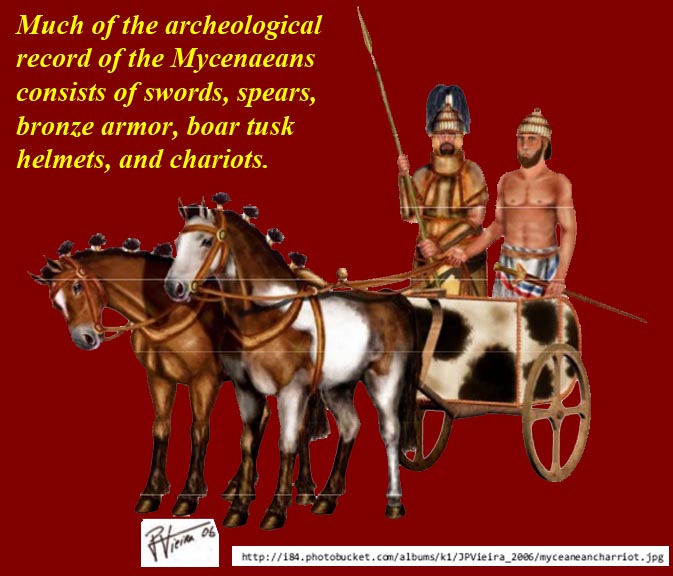
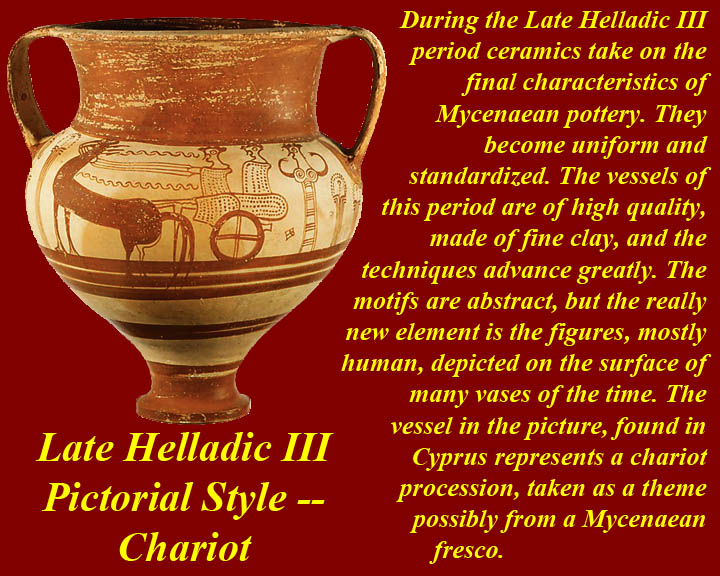
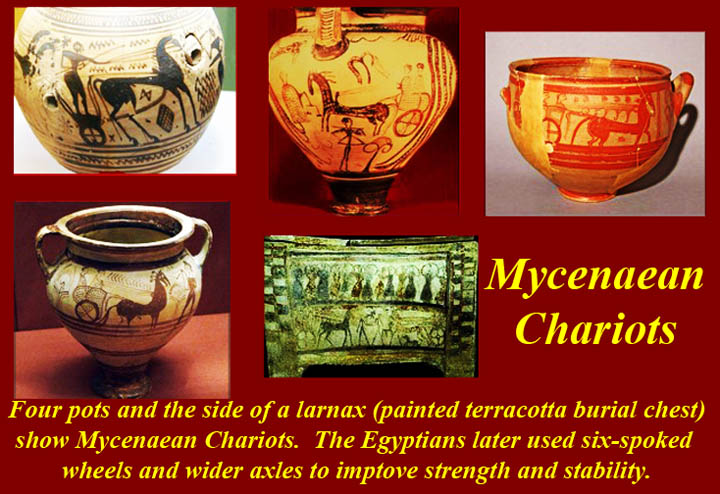
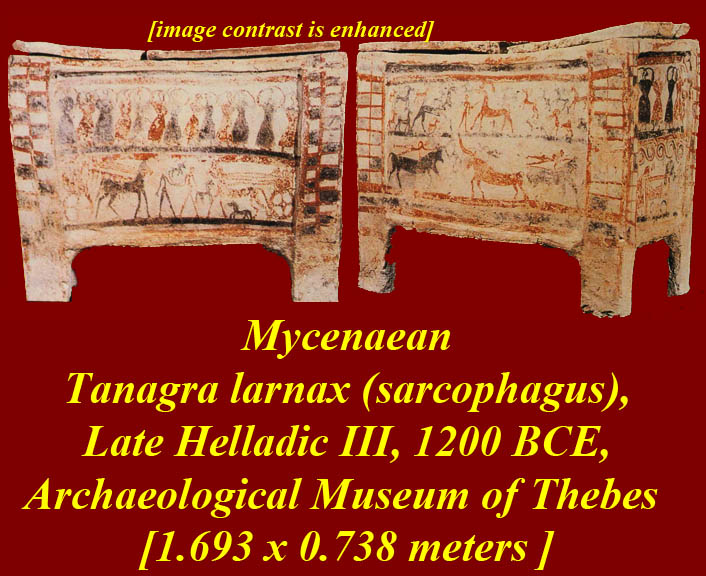
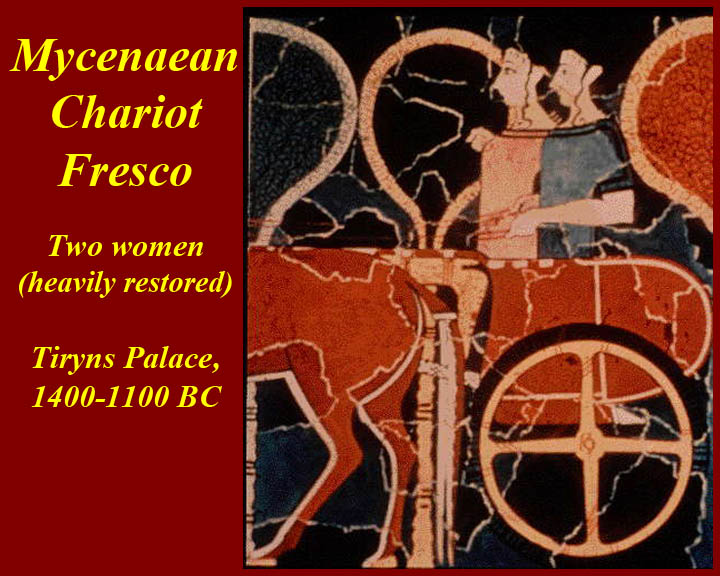
Mycenaean Greeks made use of chariots in battle. Administrative records in Linear B script , mainly in Knossos, list chariots (wokha) and their spare parts and equipment, and distinguish between assembled and unassembled chariots. The Linear B ideogram for a chariot is an abstract drawing, showing two four-spoked wheels.
Chariots fell out of use with the end of the Mycenaean civilization, and even in the Iliad, the heroes use their chariots merely as a means of transport, and dismount before engaging the enemy. Chariots were retained only for races in the public games, or for processions, without undergoing much alteration. Their form continued to correspond with the description of Homer, though they were lighter in build, having to carry only the charioteer.
It should be noted that neither Greek nor Roman chariots were ever used within city limits -- grooves in urban pavements were intentionally cut by road builders to keep ox carts on track rather than being "worn into the pavement by chariot wheels" (as many local guides and guidebooks persistently maintain).
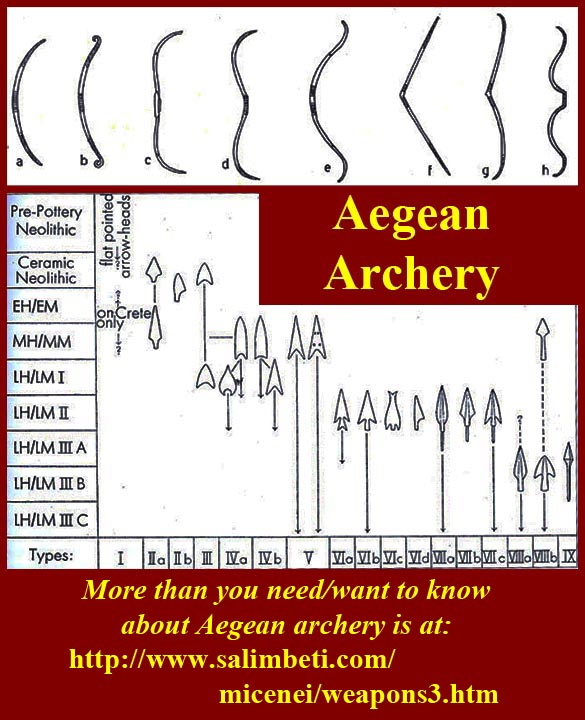
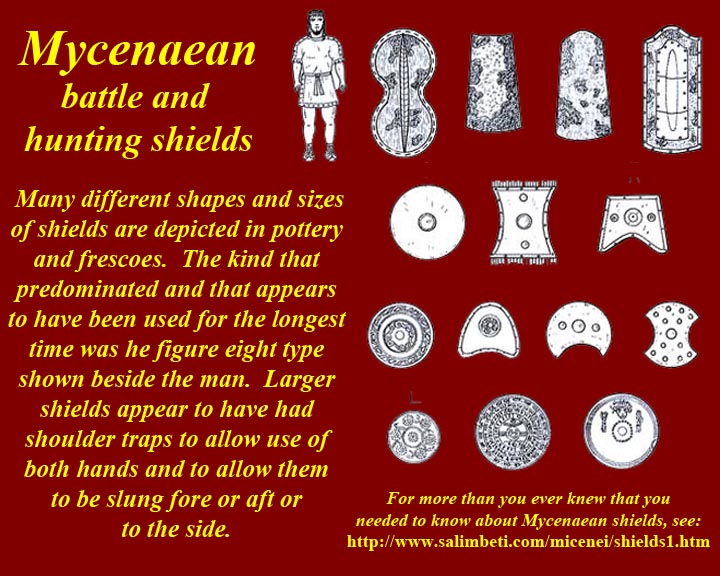
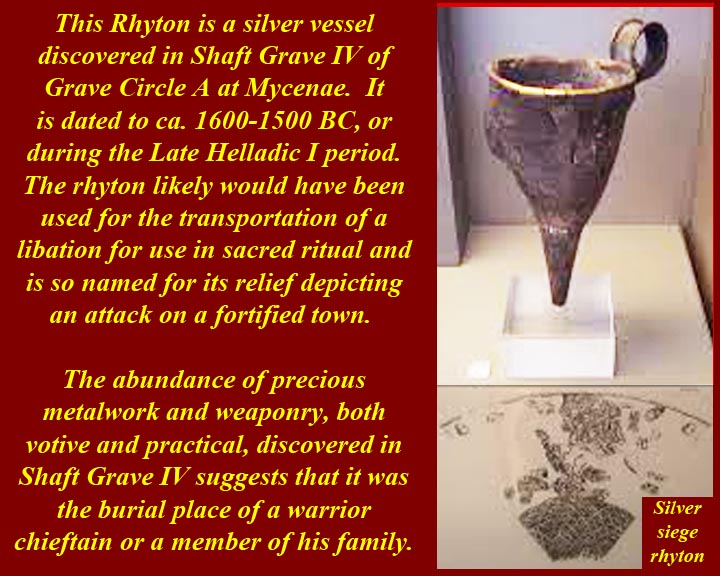
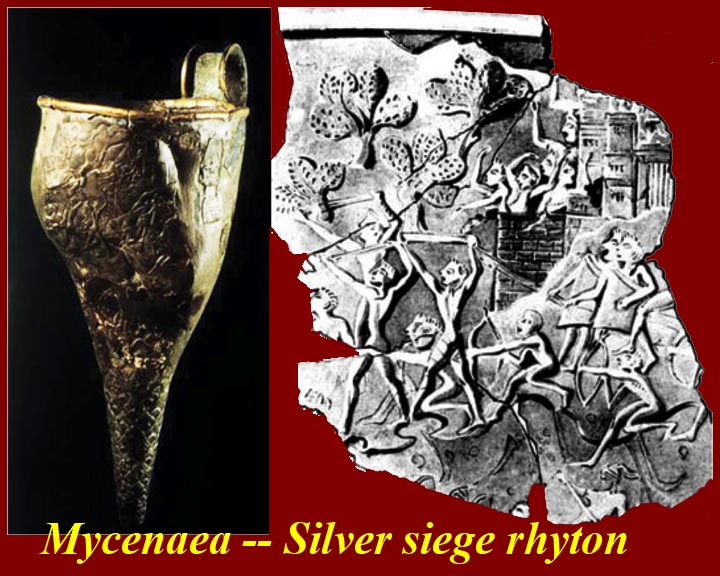
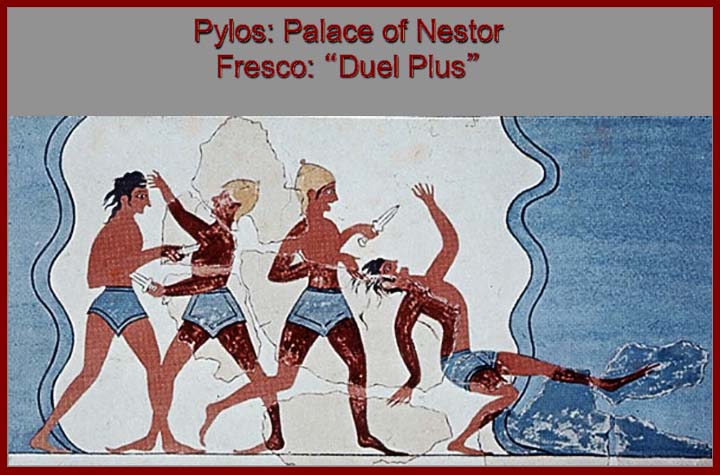
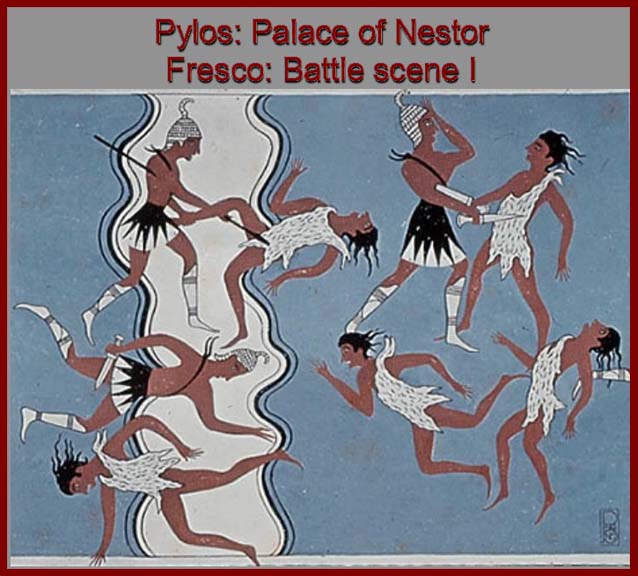
Weapons, wars, battles -- recurring themes in Mycenaean sites and imagery.
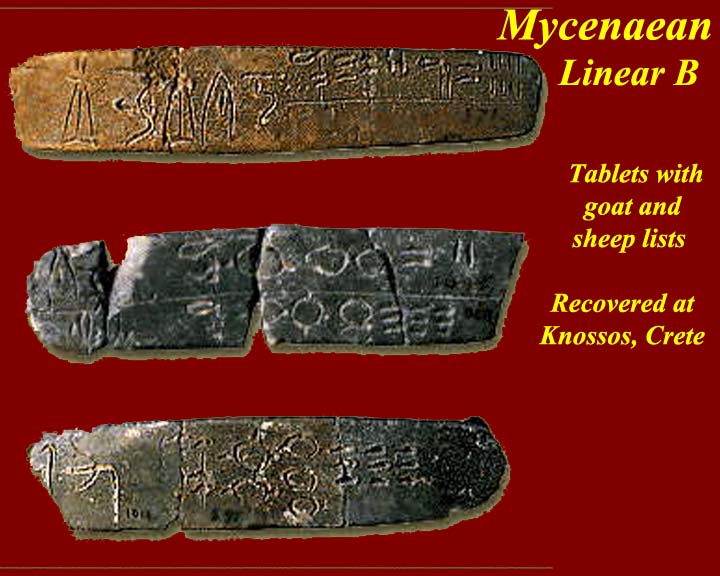
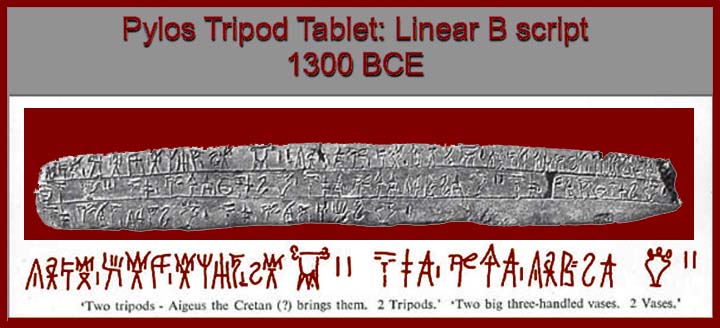
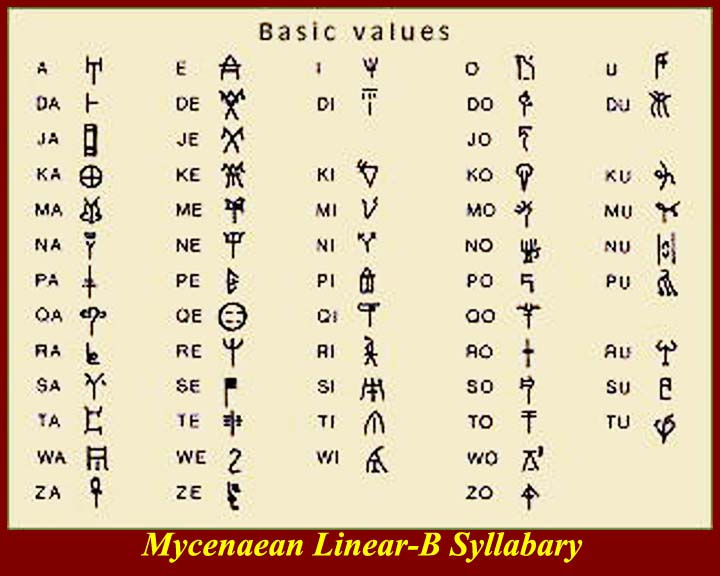


The Mycenaeans clearly adopted and adapted Minoan Linear A and used it as Linear B.
Linear B was finally recognized as an ancient form of the Greek language throught the work of Alice Kober and Michael Ventris, although the indisputable contribution of Alice Kober is often ignored, and Ventris is called "The man who Deciphered Linear B"(see http://www.amazon.com/The-Man-Who-Deciphered-Linear/dp/0500289980).
Also see https://en.wikipedia.org/wiki/Linear_B
and http://www.ancientscripts.com/linearb.html
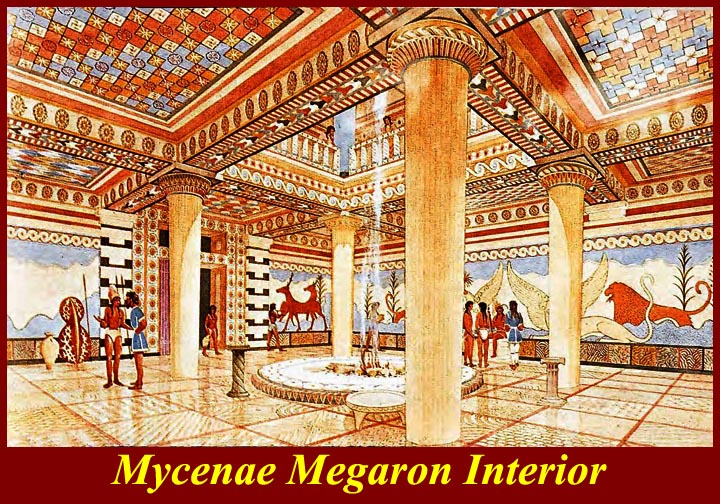
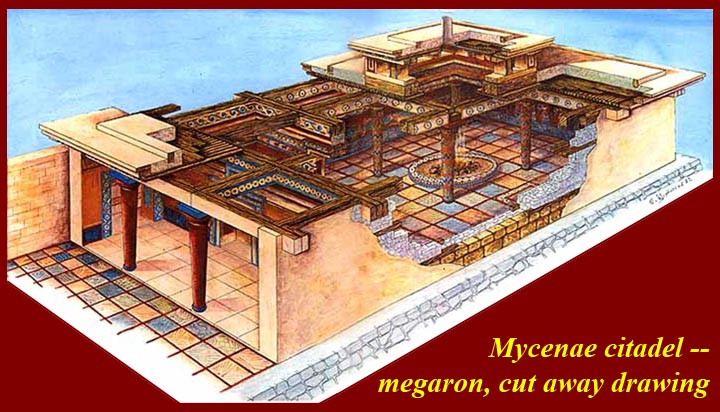
Mycenae Megaron: Important Mycenaean towns had megarons around which all important "royal", administrative, and cult activities apparently revolved. Almost invariably they had rectangular footprints and were divided into three sections: a pillared porch; a short outer chamber (later called a pronaos) and a larger inner chamber (later a naos which was a Greek word for temple or sanctuary -- corresponding to the Roman cella). At the center of the inner room would be a circular fire hearth surrounded by four roof-supporting pillars. An opening, sometimes surrounded by a second floor balcony, let smoke and heat escape. The whole megaron might be surrounded by ancillary rooms -- in fact the whole of the rest of the palace around the megaron might be considered to be composed of such rooms. The architecture had clearly evolved from that of a simple house with a main living space having a central hearth and smoke-hole (much of which evolution took place in earlier Minoan" palaces). The megaron also appears to have been the prototype for the Greek Temple.
-------------------------------
-------------------------------
On the internet you can find hundreds, thousands of examples of Mycenaean decorative arts: frescos, painted and molded ceramics, signet rings, seals, engravings. The simpler designs of Early and Middle Helladic cultures had been overtaken ("invaded?" or "conquered?") by Minoan styles and conventions. The exception being an increase in the depiction of war and warlike themes -- that came from the Helladic background -- but the folks inbolved still look Minoan. During the late Middle Helladic period there appears to have been a gradual contact-driven process of "Minoanization", but after the tsunami destruction of the Minoan cultural hegemony, after the Helladic people centered around early Mycenae took Crete, a very rapid cultural evolution came. It can be argued that this quick evolution is what engendered the Mycenaean period and provided a dividing line between Middle Helladic and Late Helladic. The latter is called Mycenaean simply because, given the militant propensities of the mainlanders, a dominant mainland metropolis was bound to be somewhere -- which happened to be in Mycenae.
A similar process of cultural "invasion"occurred later when Rome absorbed and was "conquered by" Greek culture, and again when classicist American founding fathers, having been exposed to Polybios and his French disciple Montesquieu, tried to emulate the Roman republic which Polybios had described.

